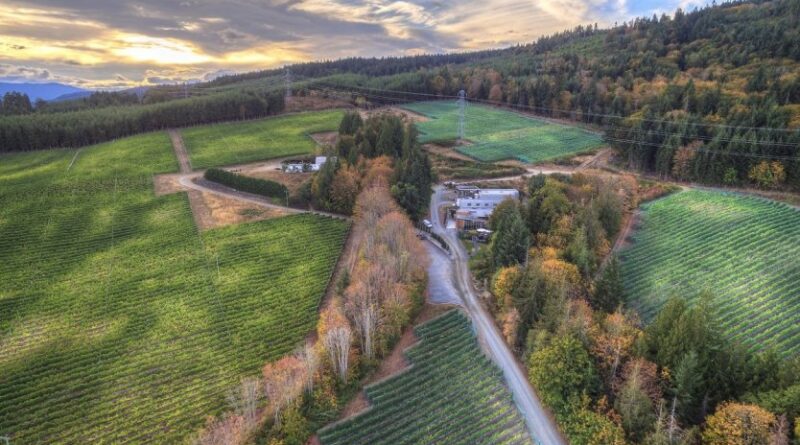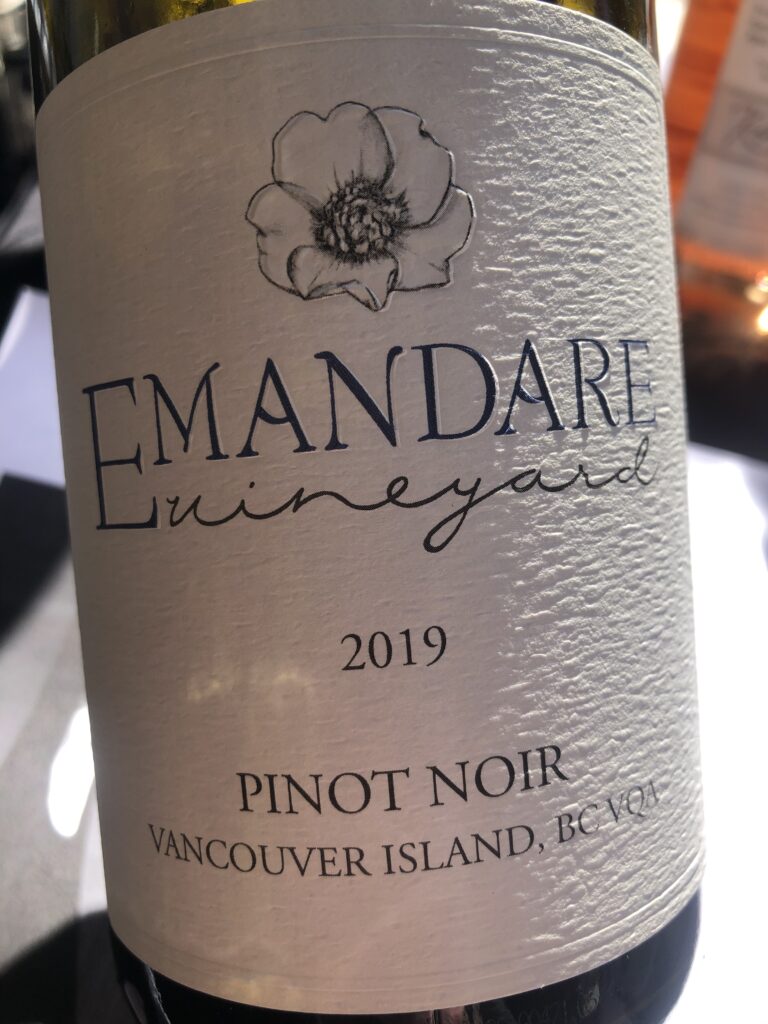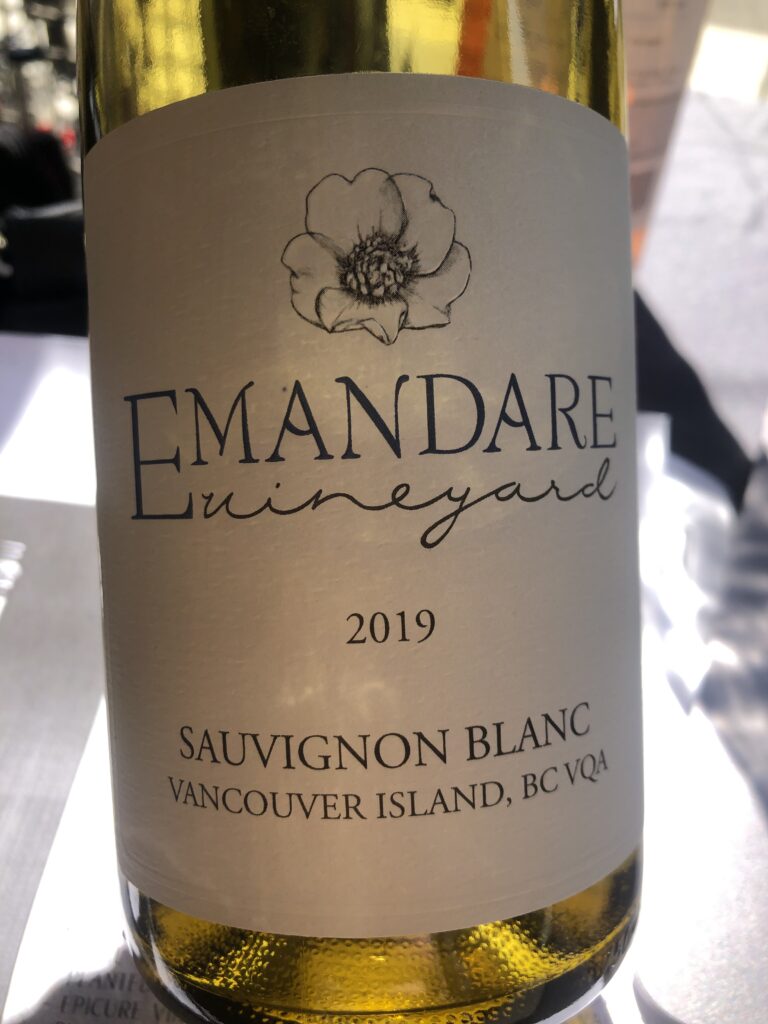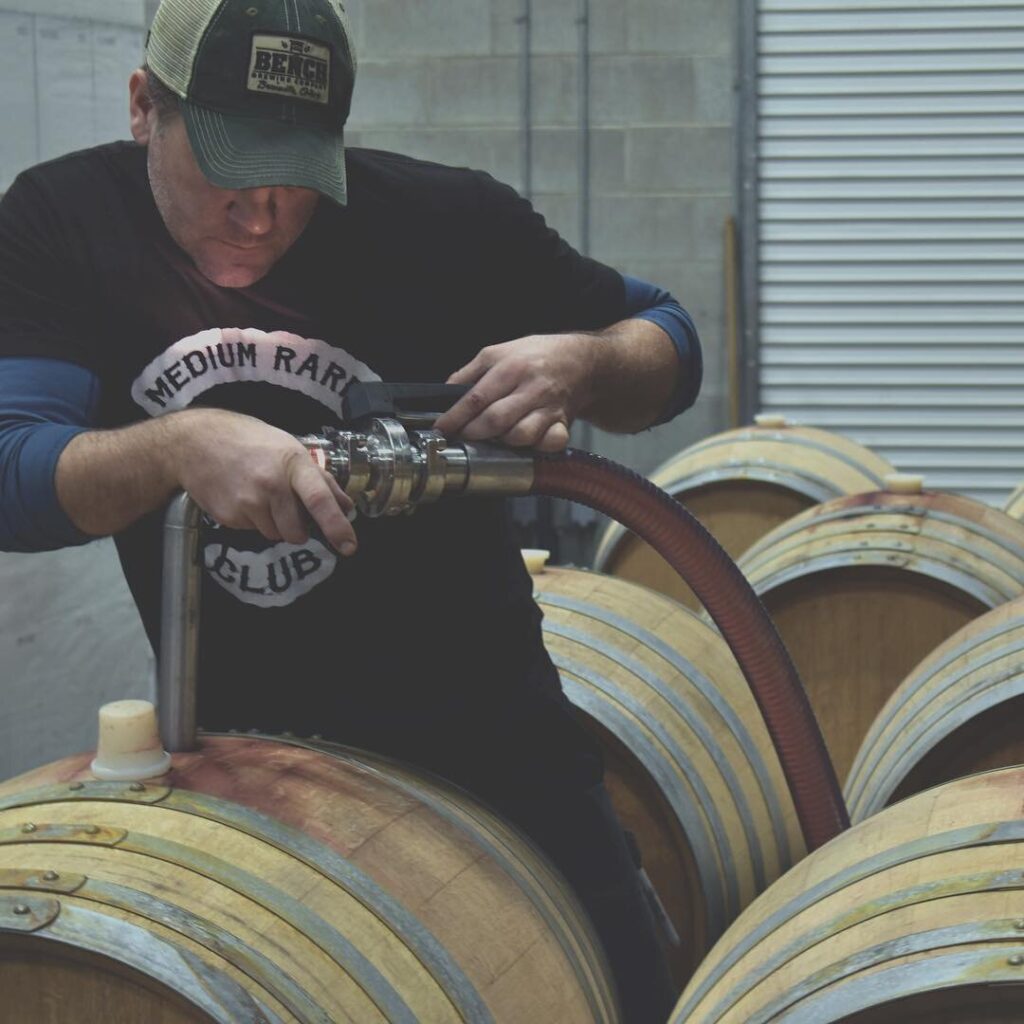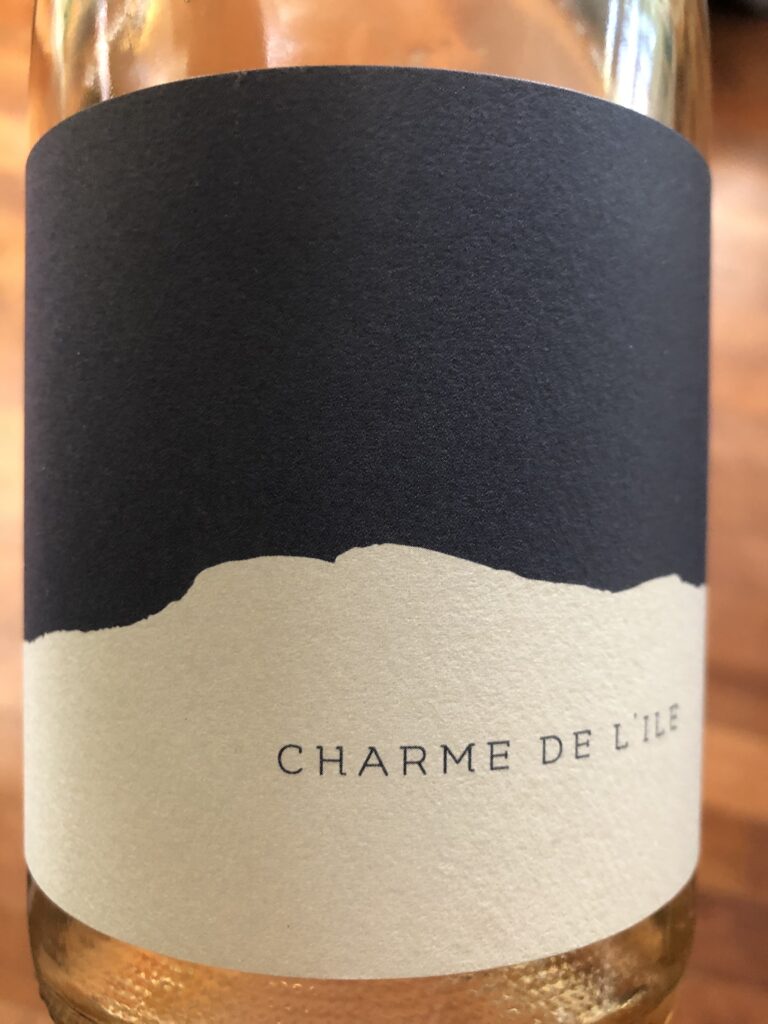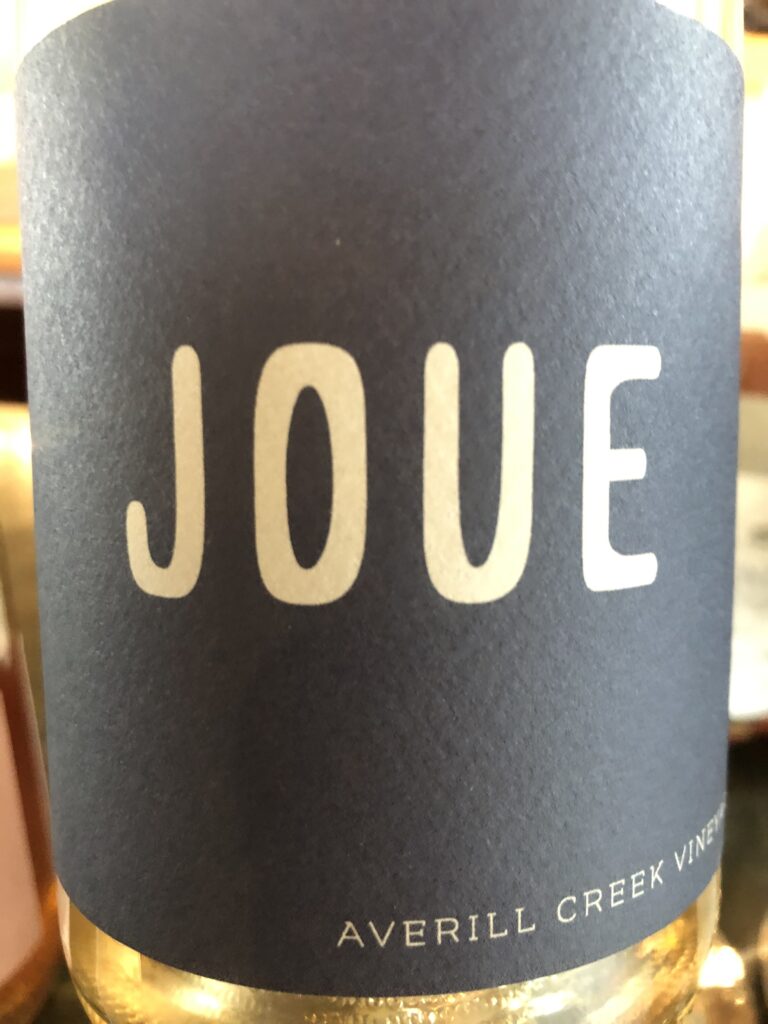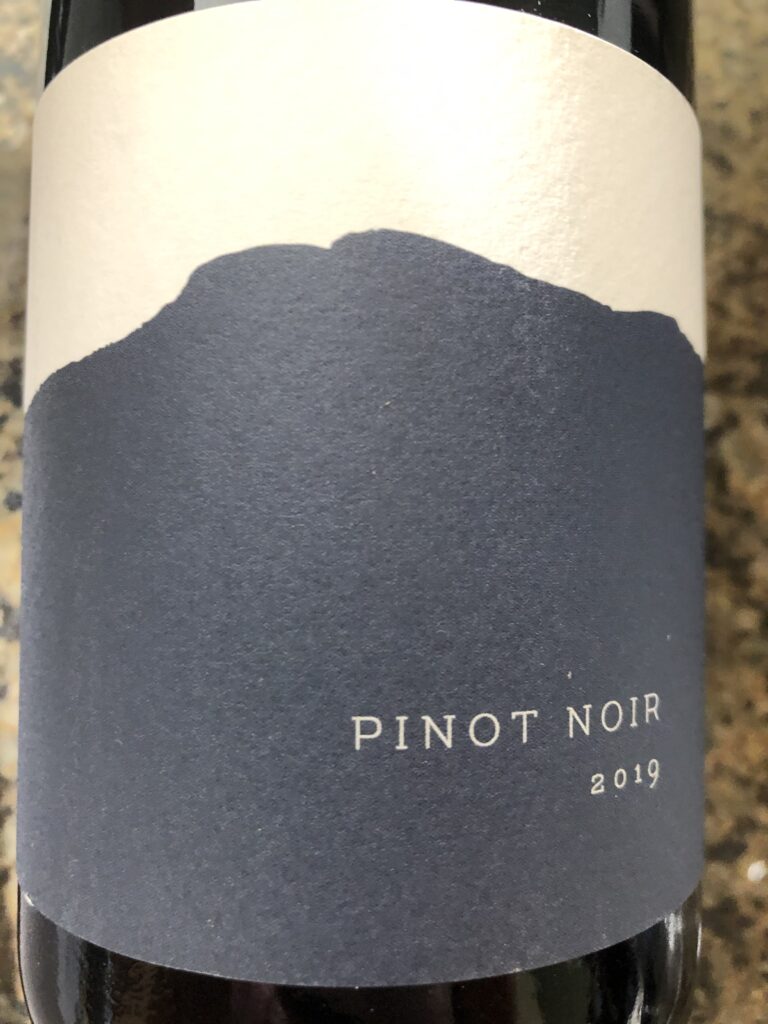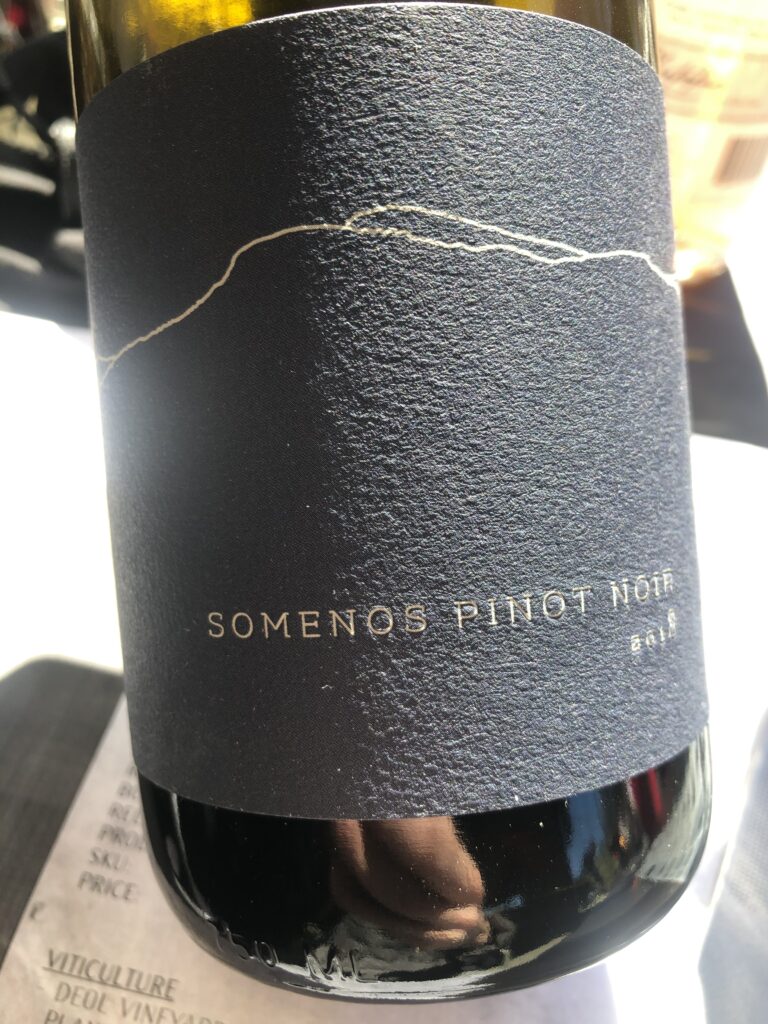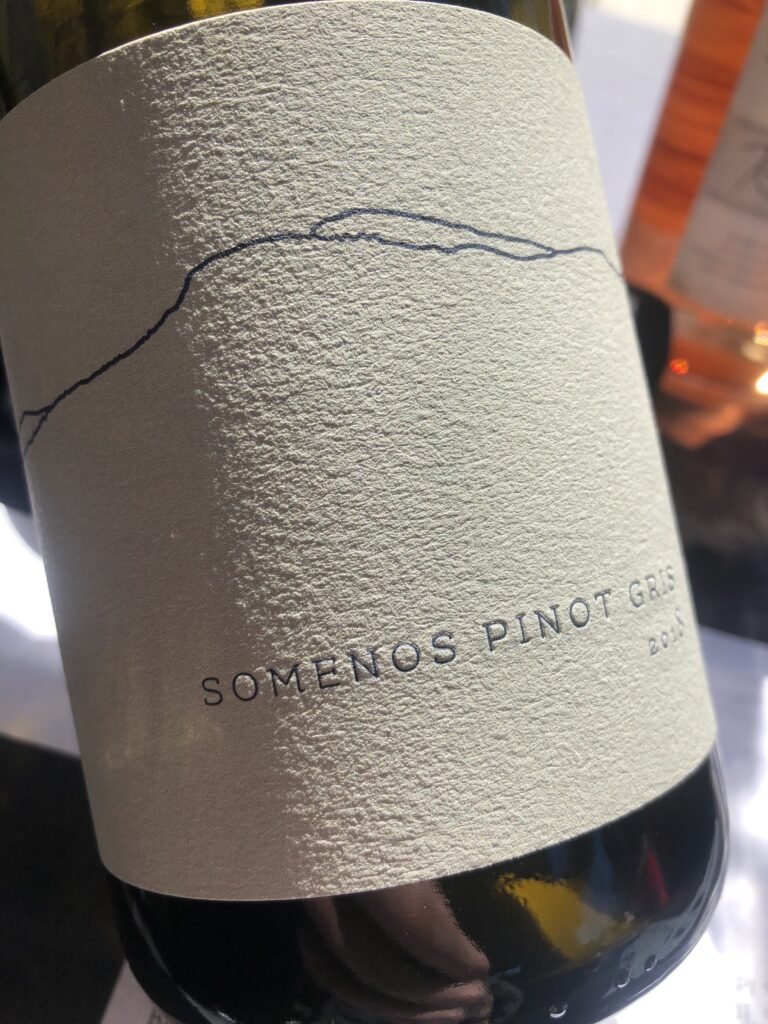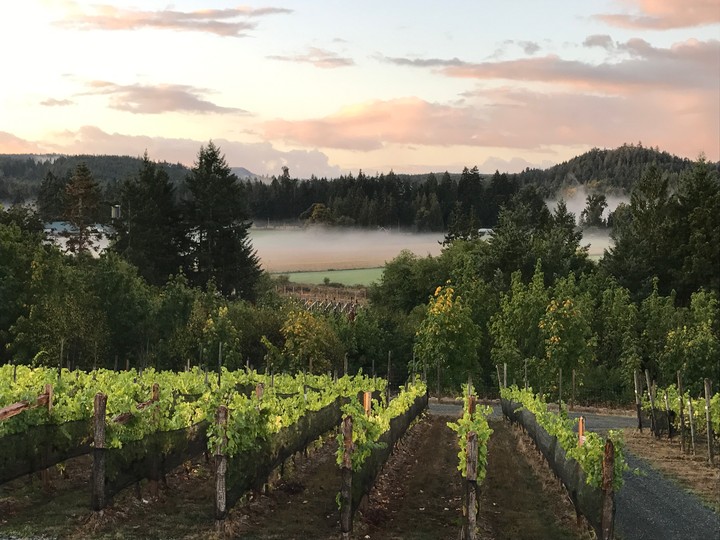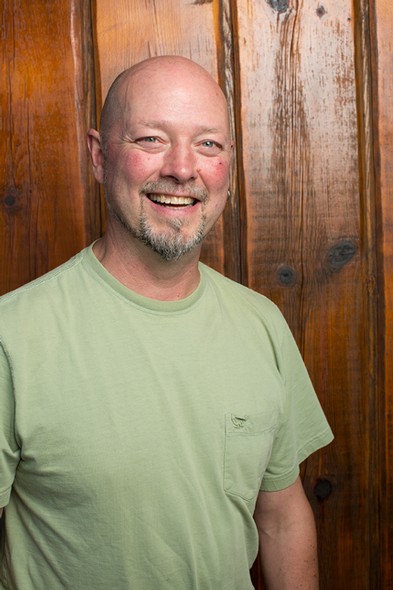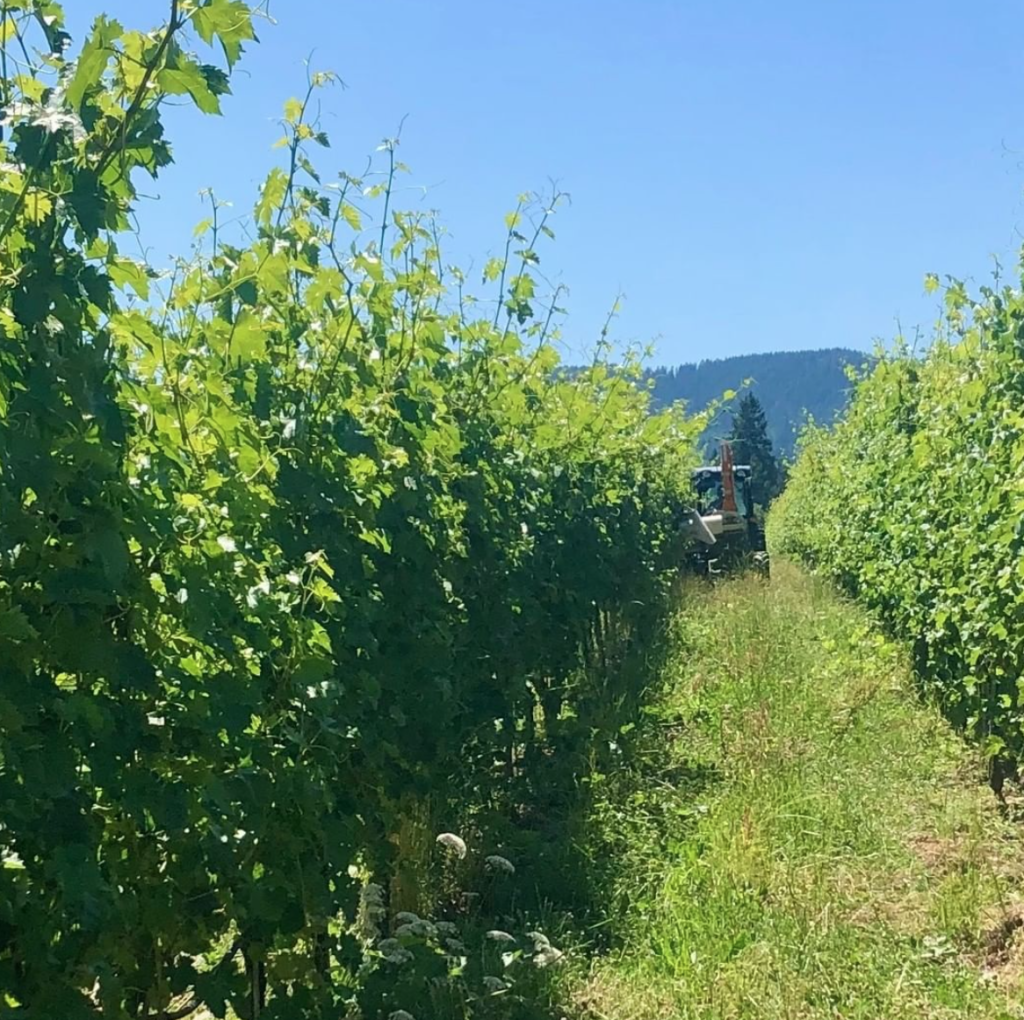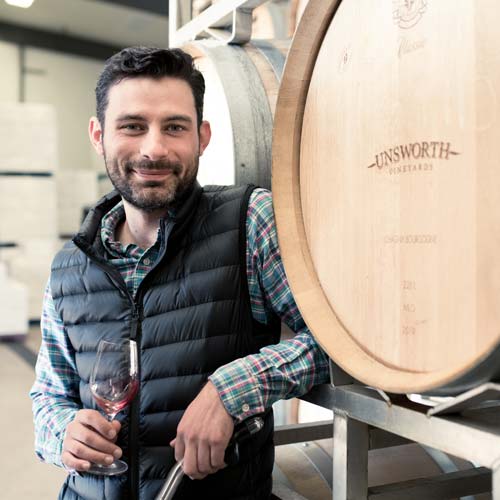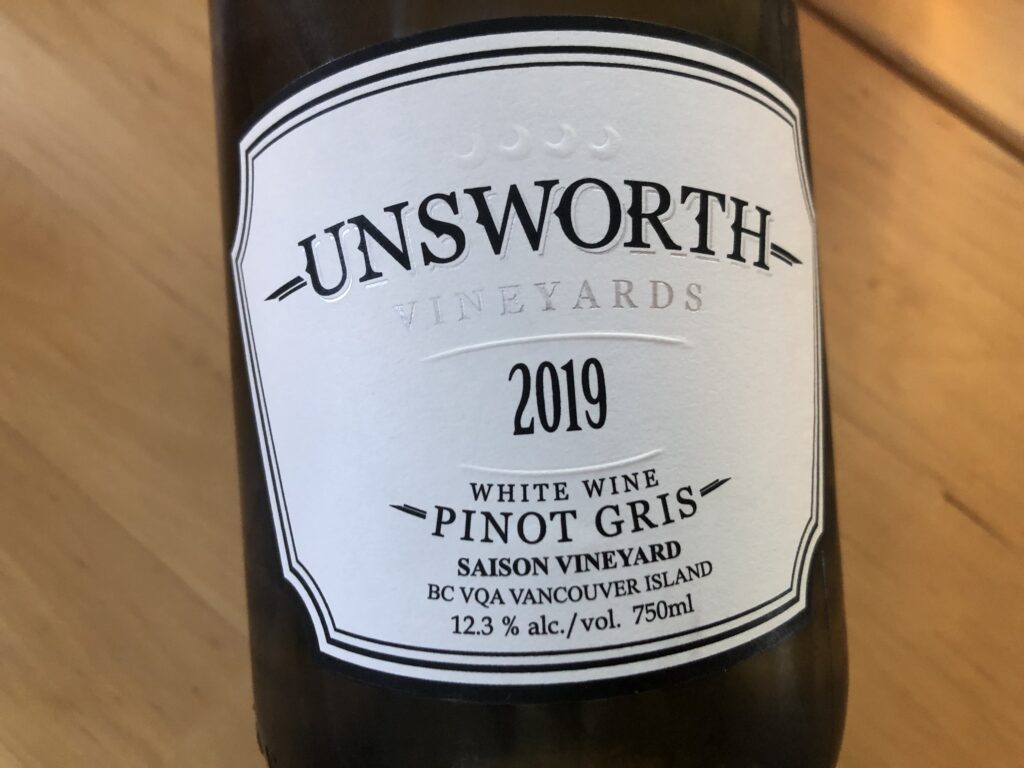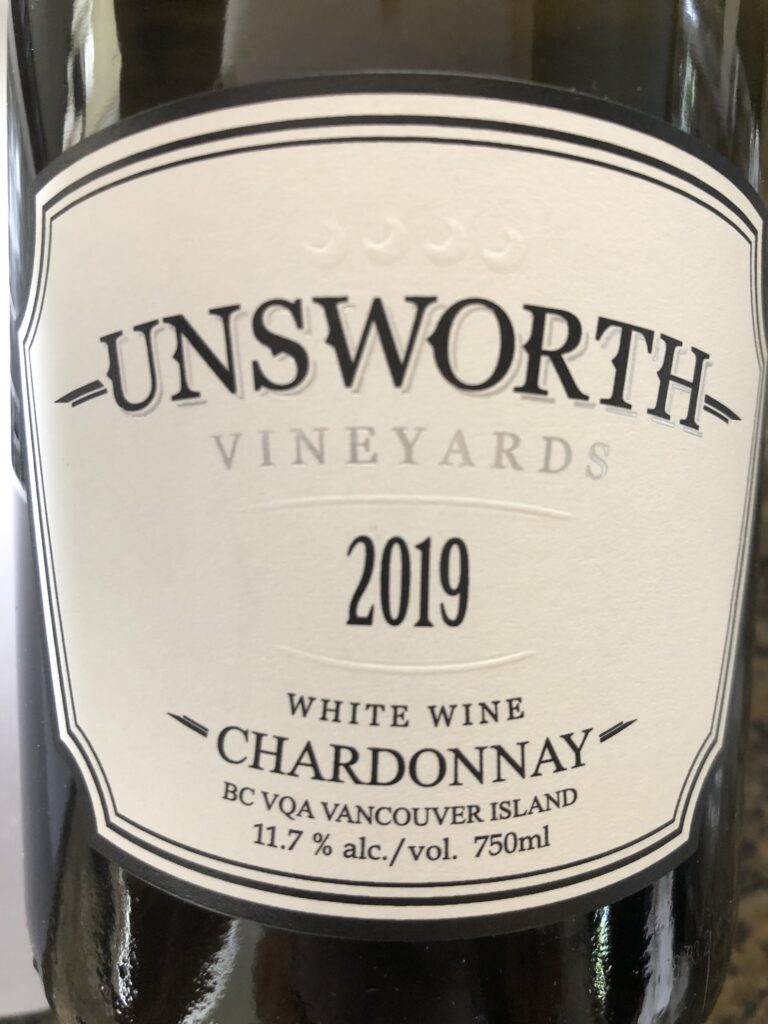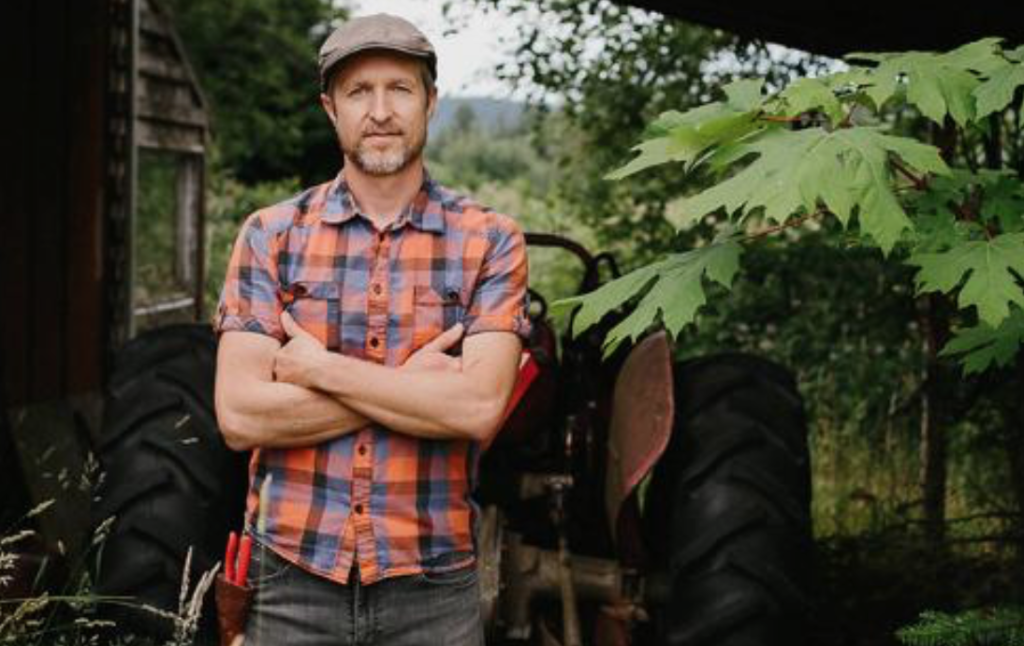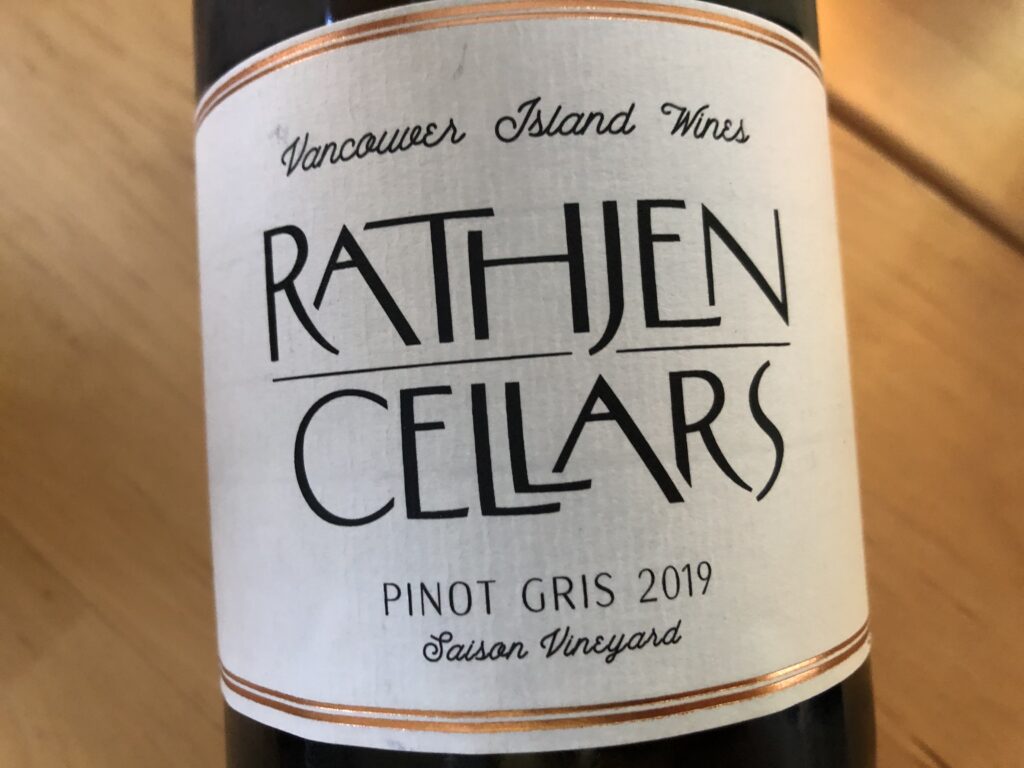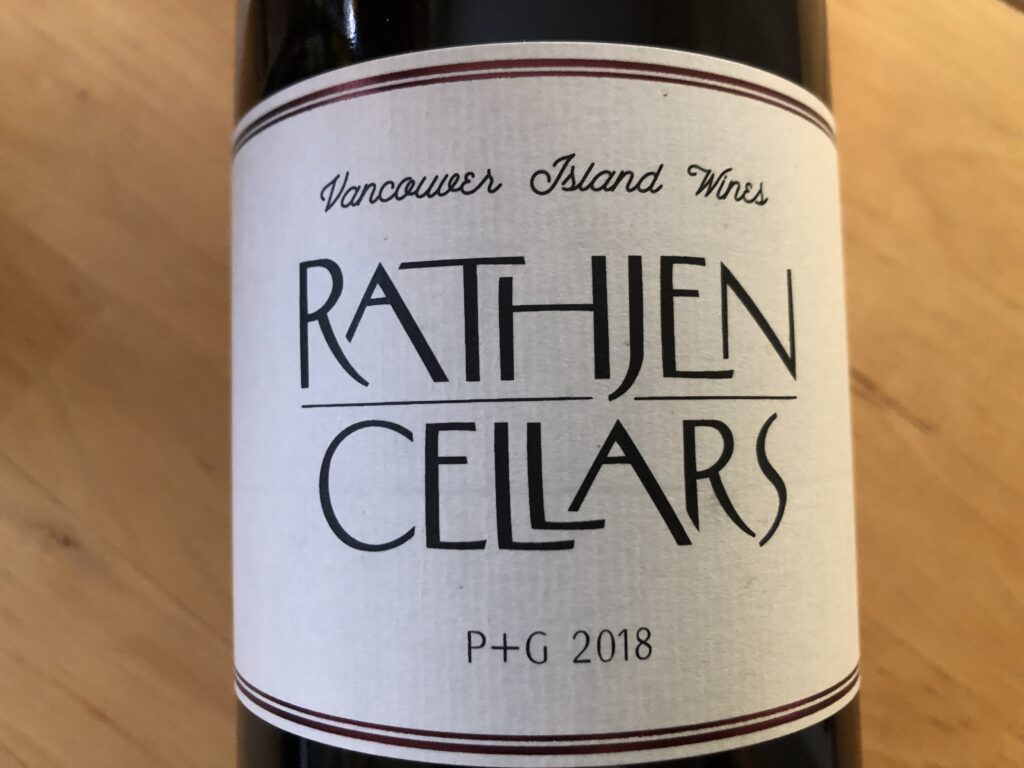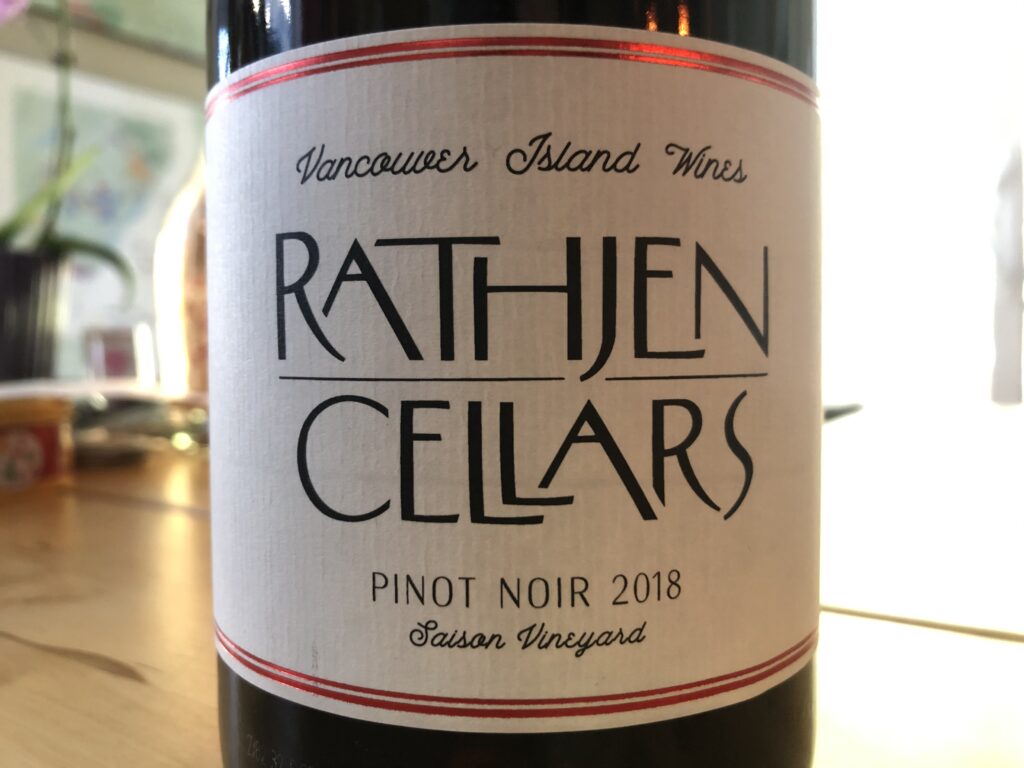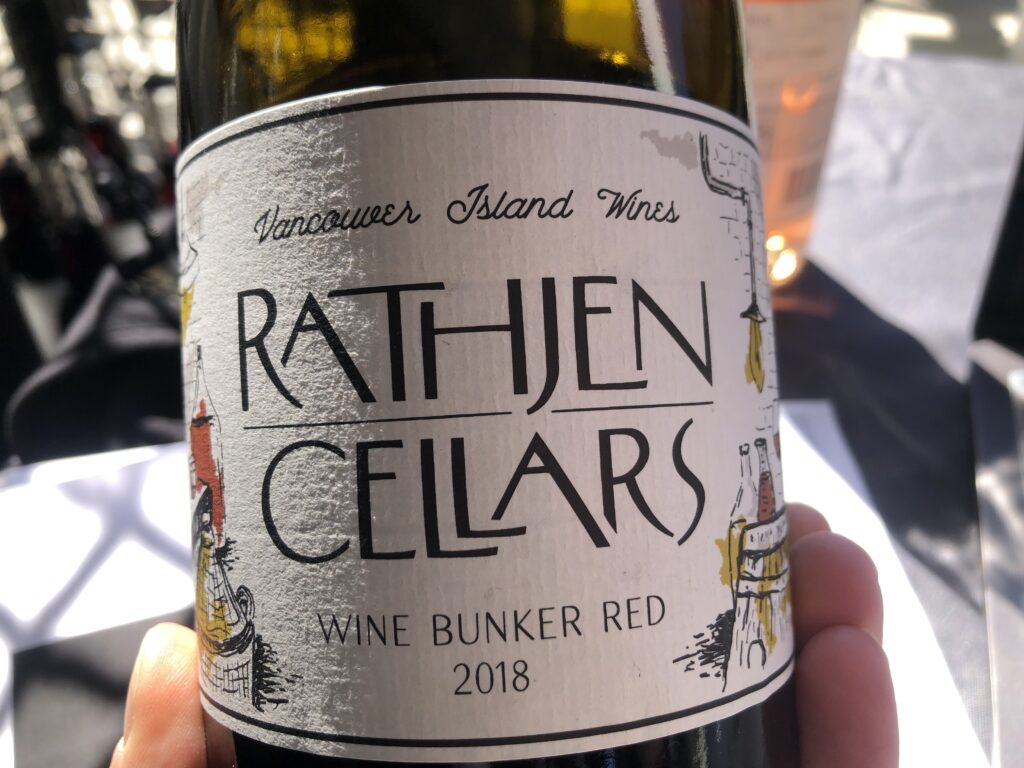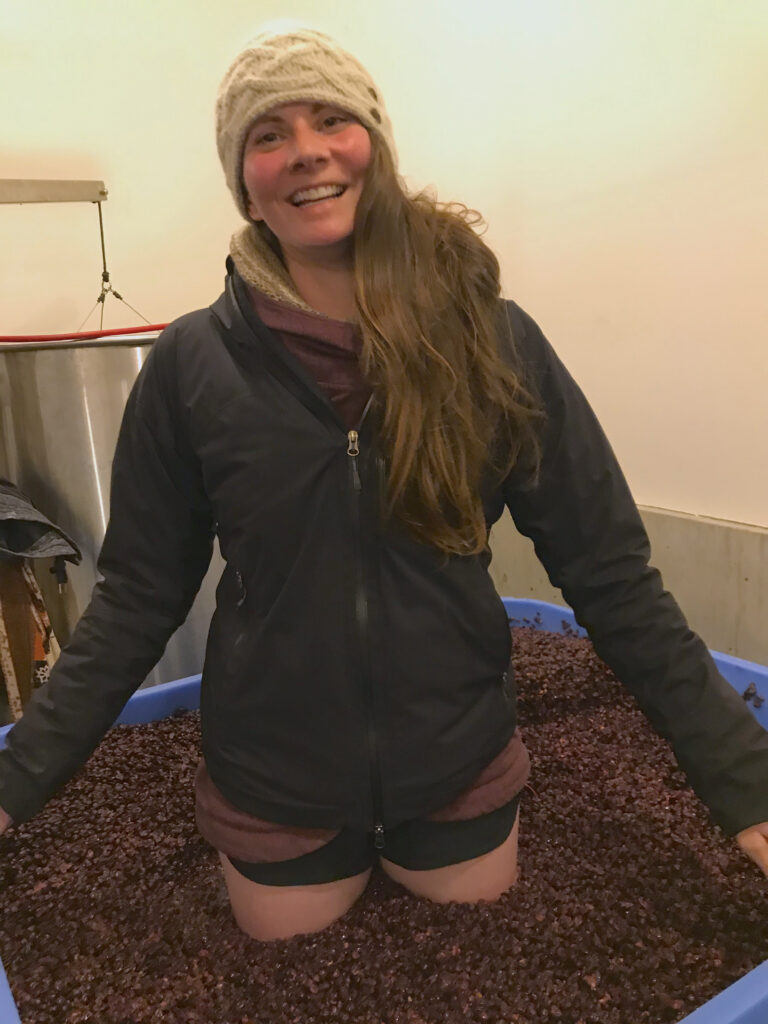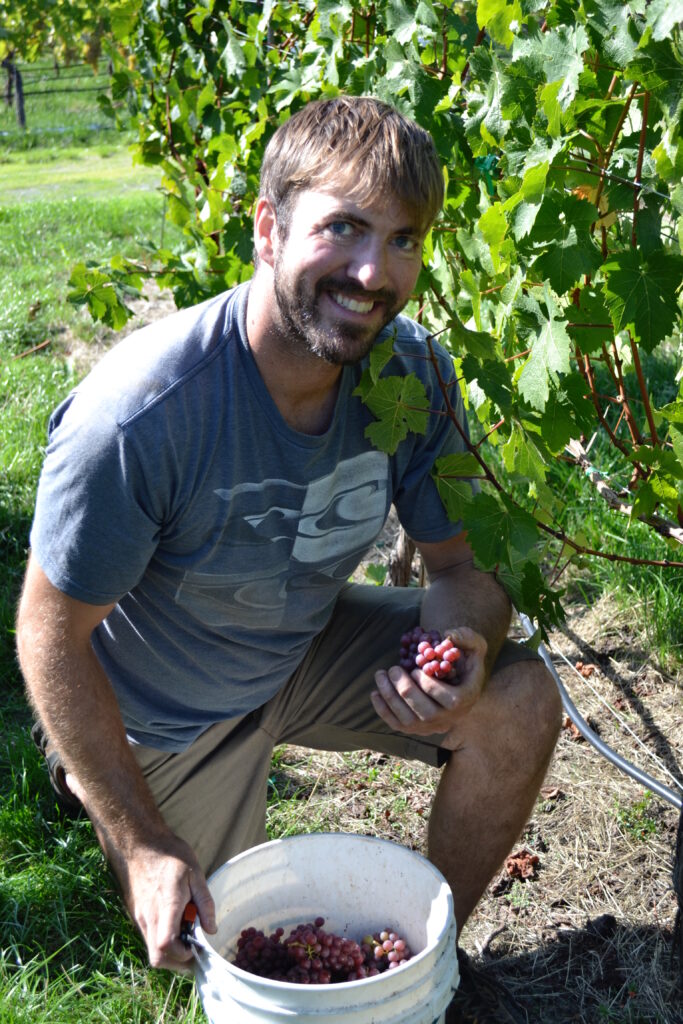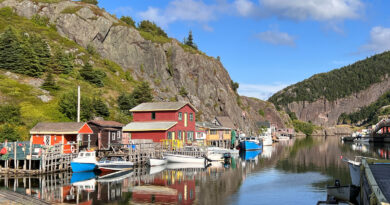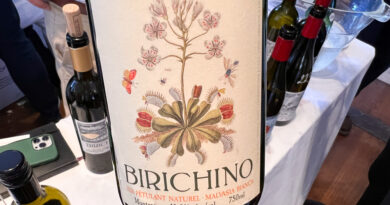Canada’s Exciting Western Edge: The Wine Islands
Though the Wine Islands are tiny in comparison to the mighty Okanagan Valley, they’re now a hotspot of wine for British Columbia. Marine swept and volcanic-borne, the Wine Islands are an unofficial name for the collective of wineries on Vancouver Island and the Gulf Islands, off the southwest coast of Canada. After decades of experimentation, much by hobbyist farmers, the region has quickly matured in viticulture and viniculture. In the 1970s-1980s, the provincial government provided agricultural tax credits for planting vineyards, resulting in 100+ different varieties to be planted and trialed, including everything from Cabernet Sauvignon and Black Muscat through to hybrids, the latter still in play in numerous vineyards today.
The past decade’s growth in talent and research has garnered an increase of interest and investment from around the globe. Today there are more than 30 commercial wineries on the Wine Islands, with more than 250 acres under vine.
Lay of the Lands
The Islands are volcanic in origin, created by an ancient seafloor uplifting, with subsequent glaciations, recessions, and tectonic activity (the area is part of the active Ring of Fire) creating a mosaic of soils. Marine sediments, glaciofluvial sediments, morainal sediments have deposited varying amounts of silts, clays, sands, and gravels, and numerous valleys and slopes to work with. Vineyards generally rest between sea level and 250m, hovering around the 48thParallel North. To put that into perspective, Champagne rests at 48-49.3N, and Bourgogne at 46.3-48N. 37 independent soil types have been identified, catalogued, and mapped on Vancouver Island, the largest island by far, stretches 500km southeast to northwest, spanning all terrains from sandy beaches to rugged coastlines, marshy lowlands to rolling farmland, and lush, old-growth rainforests to snow-capped mountains. Vancouver Island is also home to BC’s provincial capital, Victoria.
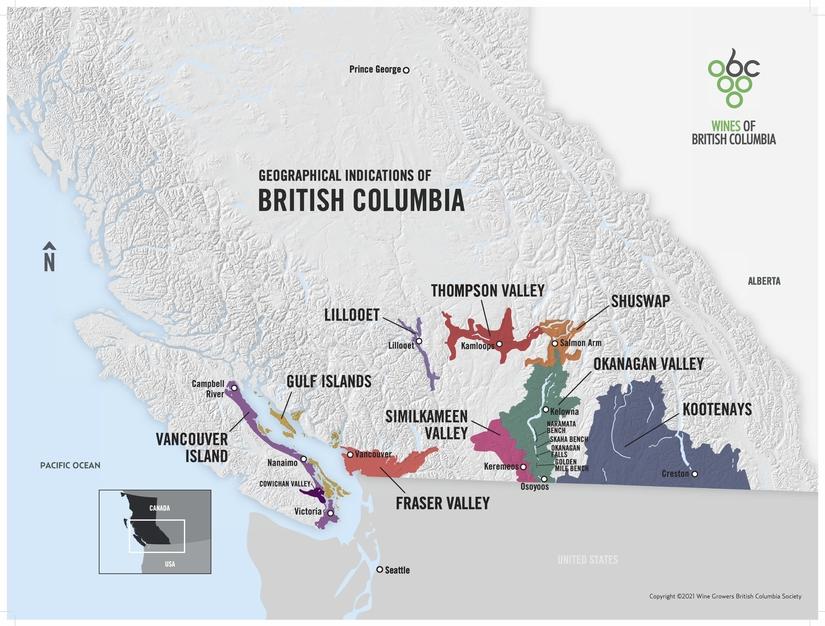
The Gulf Islands, between Vancouver Island and the BC mainland, number near 100, 13 of which are large enough to support homes and cottages, and a few of which (Salt Spring Island, Pender Island, Hornby Island) also hold commercial vineyards.
Of course, being surrounded by the cool Pacific Ocean shapes the wines as much as the soils do. The term ‘maritime climate’ is easy to understand. As the name suggests, these are wine producing regions that are directly affected by their proximity to large bodies of water. On the Saanich Peninsula, Vancouver Island’s second largest viticultural area, all the vineyards are within 2km of the sea. Viticulturally, the ocean’s moderating properties can be profound, sharing cooling breezes and tempering frost risk, essentially levelling out otherwise hazardous (to vines at least) climate conditions and extending the growing season. Maritime climates are characterized by warm (but not hot) summers, and cool (but not cold) winters, all good things for a vine. Seawater takes a long time to warm up in summer, but holds its warm energy long after the surrounding land has cooled down, helping to moderate the climate into the fall.
For all its benefits, a maritime climate is not without viticultural risk. As uncontrollable as the sea itself, an oceanic influence can bring shipwreck to the vineyards via damaging windstorms, excessive rain, and humidity, which increases the risk of disease. Powdery mildew and botrytis are regular threats.
The region’s main wine region, Cowichan Valley, translates to The Warm Land, the name given by the First Nations peoples who have inhabited the area for 4500 years. It’s a fitting title; the Cowichan Valley has the highest average temperature in all of Canada, creating an ideal growing climate for many agricultural products, including vines. Average summer temperatures across the Wine Islands are approximately 25C, with very few days over 30C. Growing degree days run around 950 over the past decades, though the most recent years have been much more in the 1150 range. As with every wine region, climate change is showing. Vintners are reporting hotter, drier summers (drought and wildfires are an annual threat), a lengthened growing season, and more extreme rain events, including winter flooding. Though the region shares approximately the same cumulative rain as Bourgogne, it is falling here primarily in winter, generally forcing harvest each vintage.
The Wine Islands’ Way Forward
In 2020, The Cowichan Valley was officially recognized as a sub-GI (Geographical Indication), the first BC wine region outside of the Okanagan Valley to achieve this status. The Cowichan Valley sub-GI is roughly defined as the area between the Cowichan watershed, the eastern coastline from Mill Bay to Maple Bay, and the western area of Cowichan Lake.
As vintners have learned through trial and error, rootstock, cultivar, clone, and site are key. While Pinot Noir (clones 115, 667, 777, 828 are most common) and Pinot Gris have been put forward as the benchmark Wine Islands varieties, Chardonnay is also incredibly interesting, with increasing attention being paid to plantings. Previous clones were mainly sparkling clones, which winemakers were using for table wine, to poor result. New plantings and proper clonal selection has the grape’s future looking bright. I predict traditional method sparkling wine will also be a force to be reckoned with in future years.
With any emerging wine region, there are those brave few at the forefront. Here are the 6 wineries and families leading the Wine Islands into the future, from north to south, along with my notes on recent releases.
Emandare Vineyard
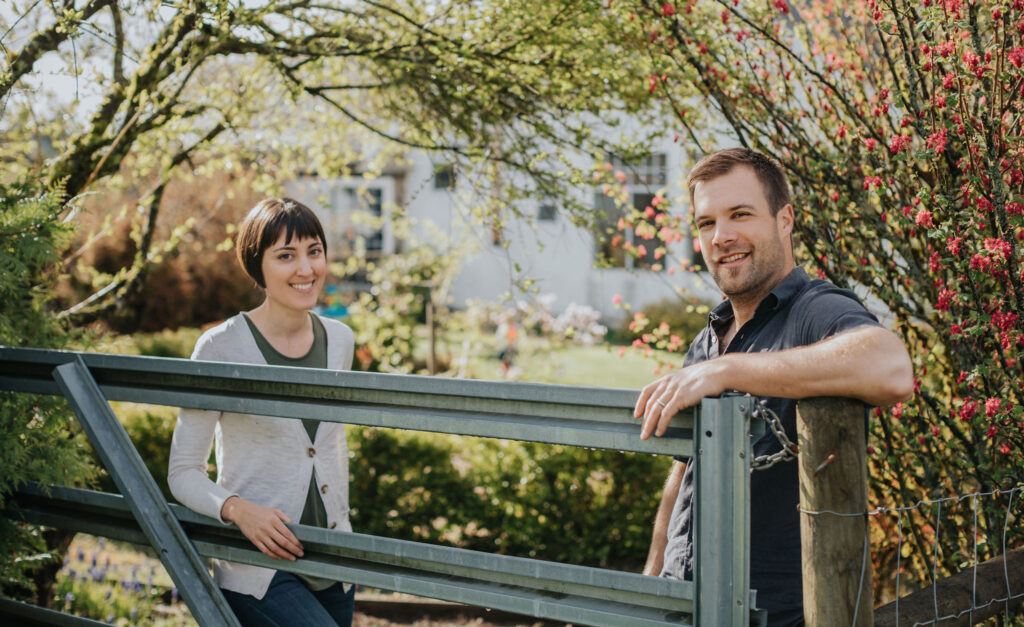
Mike Nierychlo and his wife Robin moved to Vancouver Island to raise their family, settling on a south facing terraced hillside property at the most northern point of the Cowichan Valley, overlooking Somenos Lake. Benefitting from the rain shadow of Mt Prevost, and with the beneficial lake effect, theirs is a steady, warm, hot pocket site that can achieve solid phenolic ripeness.
Their 8.5 acre estate is dry farmed organically, and they use only wild yeasts with minimal amount of sulphites throughout. They don’t turn their soils, and use ample mulching. ‘If my dirt is alive, my wine is alive’, according to Mike, who doesn’t like to be called a natural winemaker. ‘Just a winemaker’.
2020 was their 8th vintage, and the first time Mike let on that he feels like he can breathe, seeing the vineyard adapt to their organic stewardship. They’ve recently built a guest house on site, added portable chicken coops, been tearing out grapes he’s not keen on to plant things he’s excited about (more Gewürztraminer, Sauvignon Blanc), and has launched a second label in 2021, utilizing some sourced fruit, which will provide a 20-30% bump in production.
Emandare Vineyard Traditional Method Rosé 2018, Cowichan Valley, Vancouver Island, British Columbia, Canada
From the stressful 2018 vintage (they were frosted out in April, losing close to 70% of their crop), this pinot noir was picked on October 4 with a decision to make fizz. After 6 hours soaking, this was pressed, native fermented in barrel and left on lees for 3 months prior to racking to stainless. They used some of the original pinot noir juice to kick off the 2nd ferment, leading to 7 months on lees. Very young and primary, light frizzante on the palate, moving juicy cherry, and zesty red berries on the finish. Very limited amounts made of this tart, zippy fizz. 87/100.
Emandare Vineyard Sauvignon Blanc 2019, Cowichan Valley, Vancouver Island, British Columbia, Canada
From 21-year-old vines, the oldest Sauvignon Blanc on the island, this was organically farmed, destemmed and left to soak for 24 hours prior to a native ferment in stainless over one month. It then remained on lees, with no bâtonnage, for 5 months, with full MLF. Bright and vibrant with great grapefruit acidity and passionfruit punchiness, wrapped around a core of pure, warm citrus fruit. There’s an alluring textural component drawing you along the palate to the zesty, lemon pith finish. A very convincing example for SB, and organic viticulture, in Cowichan. 90/100
Emandare Vineyard Sauvignon Blanc 2018, Cowichan Valley, Vancouver Island, British Columbia, Canada
From the oldest Sauvignon Blanc vines on the Island, in the tender, organic care of Mike and Robin Nierychlo, this is a singular Wine Islands wine, and out of the few island SB’s I’ve tasted, by far the most convincing. 2018 saw this picked at the latest date ever, October 13. After destemming, this was left to soak for 24 hours, and then native fermented for 4 weeks in stainless, prior to 4 months left untouched on lees. Honeyed pineapple, tight green apple, lemon verbena flow along a textural, creamy palate, with zippy lemon zest spicing on the finish. 89/100
Emandare Vineyard Pinot Noir 2019, Cowichan Valley, Vancouver Island, British Columbia, Canada
In 2019, Emandare employed 50% whole bunch for the first time in their Pinot Noir. From organically farmed estate vines and clones 114, 115, 667, 777, this was native fermented in open top neutral French puncheons, with 10 months rest before bottling, unfined and unfiltered. Bright and fresh, with crunchy raspberry, and perfumed cherry wrapping around a soft core, with a wash of salinity on the lingering finish. Quite charming, and drinking beautifully now. 89/100
Emandare Vineyard Marechal Foch 2018, Cowichan Valley, Vancouver Island, British Columbia, Canada
The 2018 blended estate organically farmed 80% Marechal Foch and 20% Cabernet Foch, all destemmed and native fermented before 10 months in barrel prior to bottling without fining or filtration. Juicy and plump, lean and spicy, with dark cherry, brooding plum, and dark earthy notes. Tannins are low, and the palate is soft. An easy, darker red for drinking now. 87/100
Averill Creek
After decades as a medical doctor in the Canadian prairies, Andy Johnston was ready to follow his passion for wine in the late 1990s, and gained experience working in wineries in Tuscany, Australia, France and New Zealand. In 2001 Andy planted his 30-acre dry farmed vineyards on the glacially deposited stony, silty loam slopes of Cowichan’s Mount Prevost (*lede arial photo above), and built a striking four level gravity flow winery, designed around his love of Pinot Noir, and towards his goal of having the top Pinot in Canada. After many years overseeing the wines, he brought on winemaker Brent Rowland in 2018.
Brent, shaped by years as a surfing somm and winemaker around the world, has had a massive impact on the Wine Islands in only a few short years. He has worked 20 international harvests, including stints at By Farr in Australia, Calera in California, Escarpment in New Zealand, and Pearl Morissette in Niagara. A self-professed ‘neoclassical winemaker’, his goal is to make wines like they were made hundreds of years ago (in tune with nature) with the luxury and use of all the tools available today. Also a Pinot Noir lover, albeit a playful and adventuresome one, his aim is righted ‘towards fresh wines with perfume, poise, tension and nuance’. He introduced whole cluster winemaking into the red program, recounting what he learned at Domaine Dujac: ‘If you don’t understand perfume, you don’t understand pinot. Whole bunch gives perfume.’ The winery also brought in 2 x 1900L concrete eggs, as well as some demi-muids to play with. In 2020 they purchased an adjacent vineyard at the bottom of the hill, and are planting Chenin Blanc. They’ve also recently grafted over some of the Blattner hybrid varieties to Chardonnay. The winery sits around 5000 cases currently, but Brent would like to grow that to 10,000.
Averill Creek Charme de L’ile NV, Cowichan Valley, Vancouver Island, British Columbia, Canada
This recent incarnation of Charme de L’ile (tasted spring 2021) was the first made by winemaker Brent Rowland for Averill, and was the first sparkling he has made other than his pét-nat at Niagara’s Pearl Morissette. This keeps the same varieties as previous (60% Pinot Noir, 20% Chardonnay, 20% Pinot Gris), but this was foot stopped and whole bunch pressed immediately, with no sulphur added, and pressed straight to tank on full solids (as is his style), with full MLF. This charmat method fizz then underwent secondary fermentation in tank, and was dosed with 6g/L before being bottled unfined and unfiltered. Peach pit, apricot, almond fills the bright, brisk palate, with a more savoury, brown buttered bent than previous incarnations, through the ample marine salty finish. Much more on the umami, less on the fruit, and still vibrantly so. Check it out again / still. Great new packaging too. 89/100
Averill Creek Joue White Field Blend 2019, Cowichan Valley, Vancouver Island, British Columbia, Canada
The Joue line from Averill Creek is where winemaker Brent Rowland gets to play and experiment. These field blends vary from year to year. For 2019, the Joue White blended 40% Pinot gris, 40% Gewürztraminer, and 20% Chardonnay, each foot stomped with 8 hours on skins, native fermented in older French barriques, and pressed off into older oak where it remained on primary lees, no bâtonnage, until bottling, with no additions or deletions along the way. Soft lime, lime blossom, pear streams along the slender palate threaded with salinity and fine herbal lees through the lingering finish. Quite smart, and adventuresome winemaking. More like this please Wine Islands. 90/100
Averill Creek Joue Rosé 2019, Cowichan Valley, Vancouver Island, British Columbia, Canada
Pouring a deeper raspberry hue, this playful and lively rosé surprises with its forward savoury, salty drive, sculpting strawberry, rhubarb and tart red currants. There’s a balsamic twinge that rinses out the finish and hints to its naturalist roots and intention. Most definitely, you wouldn’t be able to nail its route to your glass. Winemaker Brent Rowland had three different fermenters on the go: two Pinot Noir and one Marechal Foch. He gently pressed the fruit, with the juice going into open-top fermenters onto which he destemmed whole berry Gewürztraminer (on the Foch) and Pinot Gris (on the Pinot Noir), followed by the just-pressed juice. He then proceeded like a typical red ferment (though the cap was white berries), with regular pigeage. After all, was pressed off, it was blended and left in the tank on lees until bottling with nothing added and nothing is taken away (including fining, filtration, and sulphur)—a fun adventure, and one equally adventurously fun, with a brisk chill, in your glass. 88/100
Averill Creek Joue Red 2018, Cowichan Valley, Vancouver Island, British Columbia, Canada
Winemaker Brent Rowland didn’t want to do a Bordeaux style blend, like hybrid Cabernet Foch is oft, with overwrought handling, but instead was inspired by bright Blaufrankish and fresh Gamay. This field blend of Pinot Noir, Marechal Foch, and Merlot went into the tank whole bunch, tipped with an active 30L of fermenting Pinot Gris, before the tank was sealed. With the plan for partial carbonic, this was pressed off after 2.5 weeks, at which point the marc from the Somenos Pinot Noir was added to Joue Red for a 4 day marriage before repressing. This was bottled with no additives, including sulphur. The resulting experiment worked wonders, yielding a super juicy, brisk and bright lighter red, with wild blackberry, pure plum, tight tannins and a very saline finish. Fun, and smashable, and a great red for the Wine Island. 89/100
Averill Creek Somenos Pinot Gris 2018, Cowichan Valley, Vancouver Island, British Columbia, Canada
2018 was winemaker Brent Rowland’s inaugural vintage with Cowichan’s Averill Creek, and he made his mark quickly. This striking Pinot Gris comes from a very exposed part of the vineyard, with stony gravels interspersed with sandy loams. There is a little bit of botrytised fruit in here, adding a subtle savoury note. After foot stomping and leaving on skins overnight, this was whole bunch pressed, and native fermented in a mix of old oak barrels (85%), 1 year old barrels (10%), and new wood (5%). The wine remained there for 18 months on lees with no bâtonnage. Brent says that Pinot Gris on the island behaves a lot like Chardonnay, and I see what he means in this wine. Pear, quince, subtle orange and threads of honeysuckle are woven throughout this wine, textured with fine spicing, and finishing with a lingering salinity. Very moreish. Well done. 92/100
Averill Creek Vineyard Pinot Noir 2019, Cowichan Valley, Vancouver Island, British Columbia, Canada
From the earlier accessible clone 115 (with a tip of 667/777), this is entirely whole bunch, native fermented, in older barrique, where it spent 10 months without racking, until bottling unfined and unfiltered, with a dusting of sulphur. The whole bunch is evident through the crunchy acidity brightening early raspberry and strawberry, crisp plum, and tight, fine, grippy tannins. There’s a lovely tension and energy in this youthful wine, strung with a salinity that runs front to snappy back. 89/100
Averill Creek Vineyard Pinot Noir 2018, Cowichan Valley, Vancouver Island, British Columbia, Canada
This was mostly clone 115, an earlier-drinking red off their site. In 2018, this was destemmed, but in the future Brent plans on using whole bunch exclusively for all reds due to its tannin extraction (when well handled). This time, they added 20% whole bunch 667 and 777 back-blended in to give it additional structure. Soft, downy dark cherry, dark plum, wild blackberry has a fine grip of tannins around the sides and sticking on the juicy finish. 88/100
Averill Creek Somenos Pinot Noir 2018, Cowichan Valley, Vancouver Island, British Columbia, Canada
This was Brent Rowland’s first Pinot Noir after taking over the winemaking at Averill Creek, a winery that built its reputation on that grape. It was hard to convince Andy Johnston for 100% whole bunch, but Brent was insistent, and Andy thankfully relented. This is clones 667 and 777 off their estate, fermented in very large oak vats (also a first time) with 8% new wood, and with no pump overs, only pigeage. Dark cherry is laced with oak spicing throughout the textural, juicy palate, filled in with perfumed wild blackberry, dark and darting spices, and finely grippy tannins. Great structure through the fresh finish. 91/100
Blue Grouse Estate Winery and Vineyard
Blue Grouse is one of the oldest vineyard sites on the Island, where up to 150 different types of grapes were trialled by the Ministry of Agriculture in the 1970s. The 65 acre, south west facing estate has most recently been reborn and rejuvenated in 2012 under the Brunner family, who hired winemaker Bailey Wilkinson to oversee the winemaking. Bailey, ex-of the Southern Okanagan’s Road 13 Vineyards, has planted new vineyards for Blue Grouse, focusing on different clones of Pinot Noir and Pinot Gris, with the aim to grow their 8.5 acres to 15 acres under vine on the dry-farmed, gravelly, basalt-based estate. In addition to Chardonnay, he’s also planted Pinot Meunier, with a traditional method sparkling goal. Currently no-till, they are transitioning to organic farming, with the hopes to be certified, and to achieve a 10,000 case annual production. They also have a second label called Quill, which uses contract fruit, often from the Okanagan.
The Brunners have hired Dr Pedro Parra to analyse and map the soils and advise on vine selection. They have identified three main distinct soil types: Fairbridge (silty loam with elements of marine deposits), Hillbank (similar to Fairbridge, but with better drainage characteristics), and Qualicum (gravelly loam with excellent drainage). There are also seams of clay and gravel through parts of the vineyard.
*Most of my Blue Grouse tastings the past two years have been tank samples with Bailey. My impressions on these unfinished wines are below, without a final score.
Blue Grouse Quill Dry White 2019, British Columbia, Canada
Quill is an off-dry, aromatic Island blend of contract fruit from Cowichan and Comox, and in 2019 is made up of 35% Schönburger, 26% Pinot Gris, 22% Gewürztraminer, 17% Sieberrebe, each fermented separately in tank prior to blending. Only the gris underwent MLF. There’s some gentle sweetness here, made more apparent by the lowish acidity. There’s a bracing passionfruit / guava bite that pierces this slight wine, pulling along pithy grapefruit, mandarin, melon to a snappy, shorter, somewhat ascorbic finish. Needs a brisk chill and some veg / seafood canapés to meet. 86/100
Blue Grouse Quill Rosé 2020, British Columbia, Canada
This deeper pink hued rosé is entirely Gamay, with the hue coming from 24 hours on skins. Very silken on the palate, with strawberry jam, green raspberry, mandarin, and a sussreserve of 2 g/L to offset the crunchy acidity. 87/100
Blue Grouse Quill Gamay Noir 2018, Cowichan Valley, Vancouver Island, British Columbia, Canada
The Quill line comes from contract fruit, in this case, a nearby Cowichan vineyard. After ferment in tank, this moved to neutral French oak for MLF and 10 months barrel aging, prior to a stint in tank again before bottling. This gamay is tight and green, with sour cherry, green raspberry, and pasty, lightly sticky tannins. Best with a brisk chill. 85/100
Blue Grouse Quill Red 2018, British Columbia, Canada
This Quill Red is comprised of Cabernet Franc, Merlot, and Marechal Foch, from Oliver and Cowichan, each fermented separately and aged in neutral French and American oak for 12 months. Easy and soft with black cherry, blackberry, and dark chocolate, with plush, plump tannins. An easy, put-together red for ribs or meatballs. 87/100
Blue Grouse Quill Pinot Noir 2018 (barrel sample)
From Cowichan’s lauded Saison Vineyard, this is a blend of 667, 777, 828. Juicy and pure plum, wild blackberry, thorns is wrapped around a soft core, with downy tannins.
Blue Grouse Gamay Pet Nat 2019, Cowichan Valley, Vancouver Island, British Columbia, Canada
Very little Gamay is planted on the island, but more is going in. Bailey disgorged the bottle for the tasting. This is a sharp, tight, bone dry, zippy and zesty model, with an astringent rinse on the saline finish. Promising. 87/100
Blue Grouse Traditional Method 2017, Cowichan Valley, British Columbia, Canada
Though the front label has dropped the name Paula, this is the current incarnation of their traditional method wine that still goes by her name. From estate Müller-Thurgau, Pinot Gris, and Ortega, this spent 24 months on lees. Dried apple, green apple, brioche, toast, and subtle anise roll across the dry, tight palate, padded out with lees and toast, but carrying the Islands’ hallmark brisk marine acidity. Ideal with oysters. 88/100
Blue Grouse Estate Ortega 2019, Cowichan Valley, Vancouver Island, British Columbia, Canada
From 25+ year old estate vines, as well as some new 2014-planted vines all estate organically farmed on silt loam, gravel and sands, this is partial-dry farmed, and fermented in 3 stages of ripeness, adding extra layers to the wine. Done entirely in stainless, with no MLF, this is an excellent marine-hallmark Island white, with tight, crisp lemon blossom, lemon pith, mandarin, white peach, subtle anise, and starfruit. Lovely balance between fruit, acidity, and salinity, all in a welcome 11.6 degrees frame. 90/100
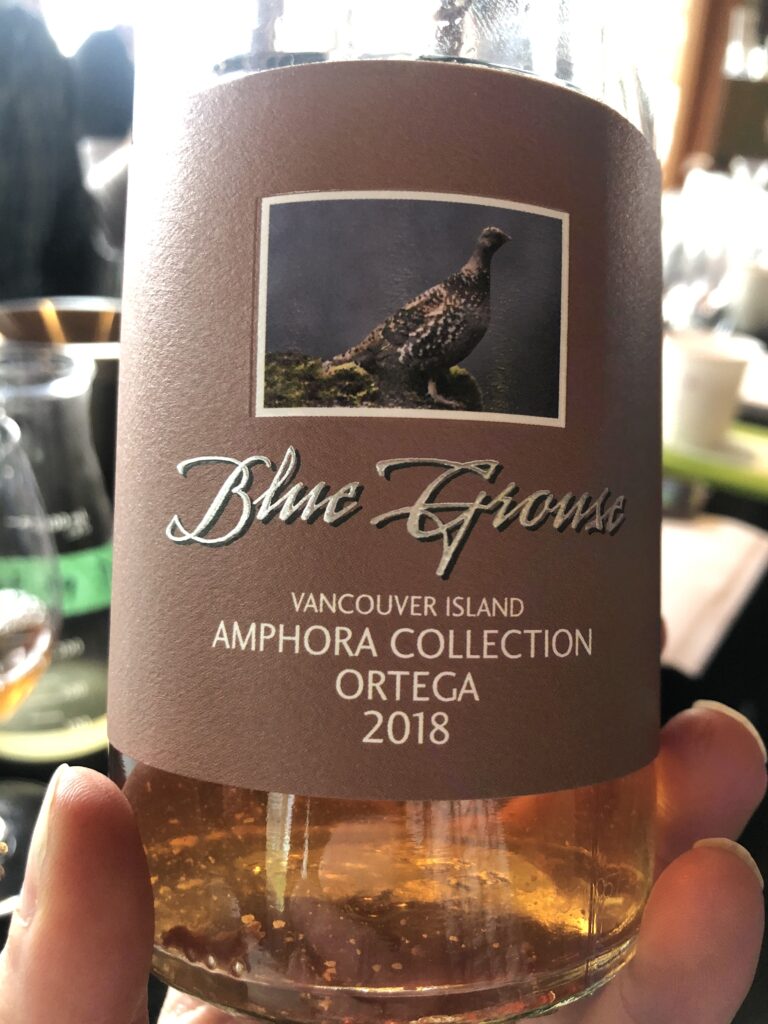
Blue Grouse Amphora Collection Ortega 2018 (sample)
According to Bailey, ‘Non intervention winemaking requires more attention than anything.’ This exciting experimental wine spent 3 months in amphora on skins. Pouring a lovely amber hue, this rings with apricot oil along a sharper, nervy palate, with a fine grip to the sides, and a slick of apricot oil on the finish. Looking forward to following this project.
Blue Grouse Estate Pinot Noir 2018 (barrel sample)
Experimenting with adding back rachis. Big, grippy wild blackberry, wild cherry, this saw 24 months in older oak. Bailey is adding puncheons into the programming for Pinot Noir.
Blue Grouse Estate Pinot Noir 2019 (barrel sample)
They’re currently the only one using amphora on Vancouver Island, a 600L from Tuscany. Pleased with the results, Baily has ordered another one. This blends 70% whole bunch Ritter clone, with 30% Dijon clone (from Saison, though under the Estate line). Quite perfumed and silky, with forest berries, black raspberries, wild plum, and juicy cherry to a spiced finish. Slightly chaptalized to offset bracing acidity. 150 cases made.
Unsworth Vineyards
By far the biggest news on the Wine Islands of late is the purchase of family-run Unsworth Vineyards by Jackson-Banke in 2020, part of the ownership group that manages the global Jackson Family Wines, and American wine giant Kendall-Jackson. Julia Jackson and Barbara Banke’s company had been seeking out cool climate vineyards, bypassing the usual Oregon sites, and deciding on Cowichan Valley. Of the climate-change prompted purchase, Julia Jackson notes ‘I did not know much about the area, but if there is one word that sums up the wines I have been tasting, it is electric. I want (Unsworth) to be a pilot project for best vineyard practices and to be the best environmental steward that I can be, of course, working with Dan and the group.’
By the group, she is referring to The Unsworth family, who bravely pushed the needle of the marginal Island climate since they began the new winery project in a decade ago. Tim and Colleen Turyk, took this on as a ‘retirement project’ in 2009, devoting ample resources including their sweat equity into the company, named for Tim’s mother Marjorie Unsworth. Together with their son Chris, and young winemaker Dan Wright, they have invested in sustainable harvesting, modern technology, and pioneering the use of marine-ready Blattner hybrids across their 33 acre property, with 11 acres under vine. Chris, a talented sommelier, and currently Marketing Director, has spearheaded the Wine Islands’ unofficial (but trademarked) appellation of style: Charme de l’ile, a Charmat-method fizz, light and fresh, from exclusively island grapes.
Ontario born Dan Wright has worked in vineyards in Niagara, Australia’s Orange, Marlborough, and the Willamette Valley. Though the majority of fruit he works with is from their Fairbridge (silt over granite bedrock) soiled estate, they also work with up to 15 various growers, including some on the mainland’s Fraser Valley and Okanagan Valley.
The family and Dan have remained in place since the Jackson-Banke changeover, with Dan noting that the new owners let each winery operate pretty much independently. The biggest change is their recent purchased of another property in Cowichan, with site prep to commence in 2021, and 50 acres to be planted there over the next few years. The focus will be on Chardonnay and Pinot Noir, with a small amount of Gamay. The site is 10 km west of Cowichan’s main town of Duncan, a warmer, south-facing site a little further away from ocean.
They are currently around 10,000 cases annual production, split between 30% sparkling, 50% white and rosé, and 20% red wine, including fortified.
*Goode and I visited the vineyard together in 2019 and tasted with Dan. His notes are included below (JG).
Unsworth Vineyards Charme De L’ile N/V, Cowichan Valley, Vancouver Island, British Columbia, Canada
Charme de L’ile is a style that some winemakers on the Island have adopted, branded, and share in, meant to be distinctly Wine Islands. The charmat-method fizz is to use exclusively Island grapes to make a lightly effervescent, delicately fruity and floral fizz, ideal for current consumption (even more ideally with local seafood). There are currently three wineries using the name, and this is Unsworth’s largest production wine. This is 85% Pinot varieties, led by Gris, Noir, and Auxerrois, and using 10% reserve wines from the previous vintage. Yellow apple, pear skin, this builds texture with lees and full MLF, aided by the 8g/L dosage. This bottle’s finish has a bitter / bruised fruit finish; chill well. 87/100
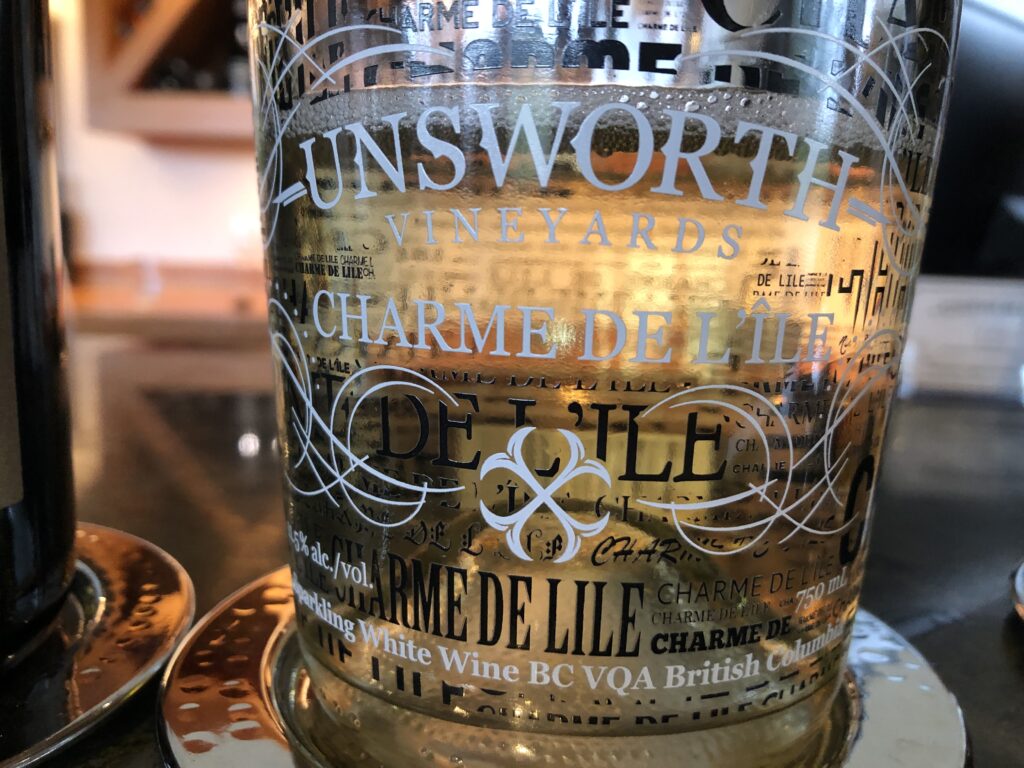
Unsworth Vineyards Charme de L’Ile NV, Cowichan Valley, Vancouver Island, Canada
Charmat method sparkler from 2015, with 80% Pinot varieties then the Blattner hybrids Sauvignette and Amiel. 2000 cases. Fruity and expressive with lively citrus and pear fruit. Clean and stylish with nice balance, made in a fruity style. 5 bars pressure here, with lees contact after the primary ferment. 88/100 (JG)
Unsworth Vineyards Charme De L’ile Rosé N/V, Cowichan Valley, Vancouver Island, British Columbia, Canada
Charme De L’ile is an unofficial appellation of style, native to the Wine Islands. It’s a charmat-method sparkling wine, of island-grown grapes, meant to typify our brisk coastal climate. This NV rosé is from Cowichan Pinot Noir, reflective in the blush hue of this easy bubble. Rhubarb, red currants, raspberries, tomato leaf, Romano cheese fill the short, fizzy palate, to a snappy, dry finish. A bit disjointed, and best taken quite chilled, with some veg or salmon dishes to mitigate. 86/100
Unsworth Vineyards Charme de L’Ile Rosé NV Cowichan Valley, Vancouver Island, Canada
100% Pinot Noir. Tangy and bright with a supple leafy green note, nice brightness, and some redcurrant and cherry. 88/100 (JG)
Unsworth Vineyards Cuvée de L’Ile 2015, Cowichan Valley, Vancouver Island, Canada
A blend of Pinot Gris, Pinot Noir and Auxerrois that spends two years on its lees. 300 cases made. Lively and intense with nice bright citrus fruit. Very linear and expressive with some finesse. 90/100 (JG)
Unsworth Vineyards Sparkling Brut N/V, British Columbia, Canada
This is the second charmat-method line of wines from Unsworth, the first being their island-centric Charme de l’isle. This blends Gamay, Pinot Blanc, and Pinot Noir from the Okanagan, Fraser Valley, and Vancouver Island into a drier, slightly more structured sparkler than the Charme. This also has 10% reserve wines added, and was dosed with 7 g/L RS. Dried apple, yellow apple, pear brioche is bedded with a pad of lees, and finishes with an apple cider note. Canapés apropos. 88/100
Unsworth Vineyards Sparkling Rosé Brut N/V, British Columbia, Canada
This is the second charmat-method line of wines from Unsworth, the first being their island-centric Charme de l’isle. This blends Gamay, Pinot Blanc, and Pinot Noir from Okanagan and Fraser Valleys, as well as Vancouver Island, along with 30% reserve wines. Those reserve wines are noted on first sniff, with an aged floral, aged gouda note, which carries onto the palate. Some dried raspberry, fresh strawberry notes join the mature notes, along with bright acidity, and a hint of spice. 7 g/L holds this pretty dry, and in good balance to the tight acidity. A bit disjointed, I’d love to see more of the pretty, fresh, primary fruit and floral flavours so much more suited to the charmat method. 87/100
Unsworth Vineyards Allegro 2019, Cowichan Valley, Vancouver Island, British Columbia, Canada
Like last year, the 2019 Allegro is a hybrid blend of Sauvignette, Petit Milo, and Amiel, from vineyards in the Cowichan Valley, Westshore, and Saanich Peninsula. This was fermented and aged in stainless on lees. This is a lean and sharp white with tight, piercing lemon, green apple, underripe melon, and subtle white blossoms, with a screeching acidity that leaves even this acid freak gasping. There’s a little lactic lees action padding this out, finishing a bit sour and short. Coastal brisk, to be sure. 85/100
Unsworth Vineyards Allegro 2018, Cowichan Valley, Vancouver Island, Canada
Sauvignette and Petit Milo are the varieties here. Fruity, lively and tangy with zippy citrus fruit and good acidity. Has a pithy note. The high acidity is balanced by 8 g/L sugar. 87/100 (JG)
Unsworth Vineyards Petit Milo 2017, Cowichan Valley, Vancouver Island, Canada
Lively and juicy with nice grip. Has a pithy, stony edge to the fruit with some good zip. 86/100 (JG)
Unsworth Vineyards Gewürztraminer 2017, Cowichan Valley, Vancouver Island, Canada
Floral, grapey nose. Delicate, fresh and supple with nice bright citrus and table grape notes. Restrained style. 87/100 (JG)
Unsworth Vineyards Chardonnay 2019, Cowichan Valley, Vancouver Island, British Columbia, Canada
This is the inaugural release of Unsworth Chardonnay, and a wave we’re going to see a lot more of with numerous Chardonnay vines going into Island soils these past couple of years (right clones this time too!). This one comes off Mildenstein Vineyard (used to be Godfrey Brownell), and was whole cluster pressed, with partial native ferment, in neutral barriques. It remained here for MLF and 10 months on lees with monthly bâtonnage. Some oxidative handling of the fruit has given a lovely nutty, flinty, brown butter note that runs the length of this fresh, streamlined wine, drawing green apple, lemon pith and peel, stones, and a slight deck of lees through the saline finish. A lot going on for 11.7%, and more to look forward to as their knowledge of working Chardonnay on the wine islands grows. Impressive first start. 91/100
Unsworth Vineyards Pinot Gris Saison Vineyards 2019, Cowichan Valley, Vancouver Island, British Columbia, Canada
From Cowichan’s Saison Vineyard, this marks the first single vineyard Pinot Gris from Unsworth. This was fermented and aged in 90/10 stainless and neutral French oak, with full MLF. Cool and sleek, with melon, crunchy yellow apple, bosc pear running to the lightly spiced, lees-cushioned palate. A touch subdued in youth, this will come around with some time in the bottle. I wish it was finished under screwcap to really let the fruit shine. 88/100
Unsworth Vineyards Pinot Gris 2018, Cowichan Valley, Vancouver Island, Canada
Supple and fresh with nice pear and apple fruit. Nice fruit here with some texture and nice depth. 89/100 (JG)
Unsworth Vineyards Rosé 2020, British Columbia, Canada
Pouring a peachy hue, this year’s rosé is pinot noir, primarily from from Damm Vineyard (82%), and supplemented with fruit from Unsworth Vineyard, and Cherry Point Vineyard, and clones 777, 667, 115. The destemmed fruit was fermented and aged on lees in stainless for 3 months. Fruit forward, with a slick palate of raspberry, cherry yogurt, mandarin, and white pepper spice to a shorter finish. Best with a brisk chill. 88/100
Unsworth Vineyards Rosé 2019, British Columbia, Canada
Pouring a peachy hue, this year’s rosé is Pinot Noir, primarily from from Damm Vineyard (82%), and supplemented with fruit from Unsworth Vineyard, and Cherry Point Vineyard, and clones 777, 667, 115. This was fermented and aged briefly in stainless. Slick and gilded with a bump of RS to make it slide down, this is filled with strawberry jam, cherry gummies, fine spicing on the shorter finish. A simple, friendly pour to chill well and crack this summer. 88/100
Unsworth Vineyards Rosé 2018, VQA British Columbia, Canada
This has some Fraser Island and Gulf Island fruit in it. Pinot Noir. Fresh and nicely textured with red cherry and strawberry notes as well as a hint of cream. Nice brightness and freshness. 88/100 (JG)
Unsworth Vineyards Sunnydale Vineyard Rosé 2020, Saanich Peninsula, Vancouver Island, British Columbia, Canada
Saanich’s Sunnydale Vineyard has been supplying Unsworth with Pinot Noir grapes since their first vintage. This is the first single vineyard rosé from that site, located on the silt slopes of Mount Newton. This is own-rooted clone 164 Pinot Noir, destemmed and fermented in neutral barrique before aging in stainless on lees for 4 months. Pouring a pale white peach hue, this is bone dry and tart with subtle cranberry, rainier cherry, and prickly pear spread across a creamy palate. The finish rings with a marine salinity and tart cranberry snap. This finishes a touch somewhat disjointed at this youthful stage, but it’s a cuvee that I’m looking forward to tracking. 89/100
Unsworth Vineyards Pinot Noir 2019, Cowichan Valley, Vancouver Island, British Columbia, Canada
The 2019 Pinot Noir comes off Saison Vineyard (76%), Unsworth Vineyard (15%), and Zanatta Vineyard (8%), all in the Cowichan Valley’s marine silt and glacial fluvial sandy loams. This utilizes clones 115, 667, 777, 828, plus 8% of an unknown clone, all destemmed, whole berry fermented in stainless before heading to barriques (10% new) for one year. Silky smooth on the slender palate, this streams forest floor, salal berries, wild raspberry, cherry blossoms, and cinnamon spicing, cut with a tart, sharp cranberry acidity. Tannins are soft and fine, through the pencil shavings finish. This new classic Island Pinot is drinking well now, with a chill. 90/100
Unsworth Vineyards Pinot Noir 2018, Cowichan Valley, Vancouver Island, British Columbia, Canada
Taken from North Cowichan’s dry-farmed Saison Vineyard, and its well-draining sloping glacial loam and rocks, this was clone 115, 777, 667, and 828. Winemaker Dan Wright called 2018 ‘an excellent year’ and ‘his favourite vintage of the past 5 years’. After destemming and an extended skin contact (30 days), this was fermented in tank, this aged in 228L and 300L French oak barrel (10-15% new) for 15 months. Very floral, with forest berries, wood berries, and the extended skin contact providing a bit more structure vs the 2017. There’s a lovely generosity to the palate, with plum, wild cherry, wild raspberry and ample perfumed rose florality, all brightened by fresh, crunchy acidity. Alluring spice carries through the pencil shaving finish. Richness, and freshness, and still just a baby. 90/100
Unsworth Vineyards Pinot Noir 2017, Cowichan Valley, Vancouver Island, Canada
This is from the Saison vineyard in North Cowichan, and the grapes are aged 15 months in second and third fill French oak, of which 10% is new. 100% destemmed. Lovely weight to the strawberry and red cherry fruit with some spice and herbs and a bit of grip. Nice flesh and structure with a touch of cedar. A very expressive style. 91/100 (JG)
Unsworth Vineyards Symphony 2017, Cowichan Valley, Vancouver Island, British Columbia, Canada
A blend of four Vancouver Island grown hybrids (Cabernet Libre, Labelle, 0583, and Petit Milo), this aged 20 months in French and American oak. The wood is very much up front and present, bashing up against the green-tinged, sour cranberry, red currant, cassis fruit. The palate is quite warming (though only 13.5%) and short, with soft, lightly gummy tannins on the sides. This very hefty bottle comes across more like a wood symphony at this point in time, illustrating why bigger reds and the Wine Islands usually make for an uncomfortable fit. 84/100
Unsworth Vineyards Symphony 2016, Cowichan Valley, Vancouver Island, Canada
This is mainly Cabernet Libre with Isabelle and 480583. Gravelly and grippy with nice blackcurrant and blackberry fruit, with good structure. Brooding and expressive with good ripeness. 90/100 (JG)
Rathjen Cellars
Based on the southern Island’s Saanich Peninsula, Mike Rathjen is quietly confident, humble and thoughtful in speech, and the understood and unspoken leader of this next gen of Wine Islands vintners. Backed by a chemistry degree, he moved to Vancouver Island in 2011 and started as a garagiste winemaker along with his brother-in-law Mike Nierychlo of Cowichan’s Emandare Vineyards, making wine from his basement ‘Wine Bunker’, the name of which gave way to his entry tier of wines. Mike works with various established vineyards on the Peninsula, as well as his small home site, planted in 2016. His are all sustainable, low-input wines, with the aim to bring local underused farmlands and vineyards back into healthy production. He has undertaken the restoration of numerous tiny hobby vineyards, currently working with 6 Saanich vineyards, and 2 Cowichan Valley vineyards. In late 2020 he took over the leases from Sannich’s DeVine Vineyards, giving him new access to 20 year old vines of Chardonnay, Pinot Gris, and Pinot Blanc.
Mike sees himself and his peers ‘In Phase 2 on the Wine Islands. It is proven we can grow vinifera here, but where do we go next?’ He uses exclusively Island fruit to authentically reflect the unique terroir and growing conditions.
The Saanich Peninsula is approximately a 30-minute drive from downtown Victoria, filled with farms, and surrounded by sea. All of the vineyards are on lower lying soils, with higher clay content over granite bedrock. While the Cowichan Valley averages 1200ml rain / annually, the Saanich Peninsula amasses around 600 ml.
Furthering his relationship with local growers, Mike also makes small lots of other imbibeables, including Scrumpy Cider, a wild-fermented cider made from apples, quince, pears and crabapples scrounged from local orchards; Crème de Cassis, a fortified fruit wine from local blackcurrants; and Imperative Dry Vermouth (below). Rathjen produced 2500 cases in 2020.
Rathjen Cellars Sparkling Rosé NV, Saanich Peninsula, Vancouver Island, British Columbia, Canada
Mike Rathjen made 75 cases of this inaugural traditional method rosé and released 25 cases worth in February 2020. This Pinot Noir pink fizz came from 25-year-old organically farmed vines from Saanich’s Brambleside and Starling Lane Vineyards, and the 2017 and 2018 vintages. After a 4-5 hour skin contact soak, the base wines fermented native in neutral barrels with no MLF kicked off secondary ferment in the bottle with primary fermenting lees and organic sugar and then aged on the lees (this second release for 18 months) before bottling unfined and unfiltered, with no dosage. Sour cherry, young raspberry, rhubarb ring through the tight palate with a cranberry tartness, and lingering salted smoke finish. Bone dry, the body is light, the fruit slender, and the acidity brisk, precisely as the Wine Islands should be. Rathjen is one of a handful of passionate Wine Islands advocates and explorers, redefining this unique region. 89/100
Rathjen Cellars Wine Bunker White 2018, Saanich Peninsula, Vancouver Island, British Columbia, Canada
The younger-drinking ‘entry level’ Wine Bunker wines are finished with Stelvin. This is a blend of Saanich Ortega and Pinot Gris into a light (11.9%), aromatic, bright lemon-led white. The slender palate leads to a long, mouthwatering and saline finish. Quite smart, whilst being friendly. 89/100
Rathjen Cellars Auxerrois 2019, Saanich Peninsula, Vancouver Island, British Columbia, Canada
From Saanich’s Dragonfly Hill Vineyard, nearby his home site, this own-rooted Auxerrois was planted in 1992/93. According to Mike, the grape ripens earlier than Pinot Gris, is disease resistant, crops higher, and is reliable. Recent DNA fingerprinting suggests the grape is a cross between Gouais Blanc and Pinot Noir, the same ancestry as Chardonnay. This was native fermented in neutral oak puncheons, where it remained on lees for 10 months, with no MLF and no bâtonnage. Green apple, green melon, wild pear run the tight, nimble and dry palate, finely creamy with a subtle white blossom perfume and zesty lemon acidity. The thirst-quenching finish lingers with marine salinity. Part of their flagship series, this is finished with cork and wax. 50 cases. 89/100
Rathjen Cellars Pinot Gris 2019, Cowichan Valley, Vancouver Island, British Columbia, Canada
One of Rathjen’s Flagship series, this is sealed under cork and white wax. From the sloping clay silty loams of Cowichan’s Saison Vineyard, this dry-farmed, clone 53 Pinot Gris was whole-cluster pressed and native fermented in neutral oak, where it spent 10 months on lees without bâtonnage, and with full MLF, before light filtration and bottling. Understated and alluringly so, with a savoury wild herb undercurrent carrying bosc pear, green apple, subtle meadow flower along a lees-bedded, creamy, textural palate. As with 2018, this remarkable salinity runs through this marine-fresh wine, lingering on the moreish finish. Distinctively Wine Islands. 91/100
Rathjen Cellars Wine Bunker Red 2018, Vancouver Island, British Columbia, Canada
This Stelvin-finished fresh red comes from two vineyards in Saanich and one in Cowichan, and blends 40% Gamay with 40% Marechal Foch, and 20% Pinot Noir. The 2018 saw the Pinot Noir and partial Gamay destemmed, with the Foch and remaining Gamay undergoing carbonic maceration over 21 days. All were native fermented, and aged for two years in neutral barrel before bottling unfined and unfiltered, with minimal sulphur. Juicy and bright, with cool stoniness, and bright, crunchy wild berry, wild plum, and cherry. The Foch peers through with candied cherry notes, making me thankful for the grace of Gamay. Suits a light chill. 89/100
Rathjen Cellars P + G Pinot Noir – Gamay Noir 2018, Vancouver Island, British Columbia, Canada
Like the previous 2016 P+G, this absolutely nails what the island needs do red-wise: bright, crisp, saline, lighter bodied, joyous reds, from entirely island fruit. P+G is a brill example of just that. This 50/50 blend of gravelled, mostly dry-farmed Cowichan Pinot Noir (Saison Vineyard) and Gamay (Deol Vineyard) takes its cue from that other marginal cool climate region of Bourgogne, and their Passe-Tout-Grains tradition of blending the two lighter reds into an earlier-drinking wine. This was cold soaked for 48 hours prior a native ferment in open top bins, with one week on skins prior to pressing. This remained in neutral French barrels for one year separately, and then was blended and returned to barrel for a year together prior to bottling without fining or filtration. Wild cherry, wild raspberry, fragrant plum, finely rasped pink peppercorns flood the slight, juicy palate, lofted with easy, marine-fresh acidity and finishing with lingering salinity. All this and 11.9%? Only half of the 50 cases made remain as of tasting time – act quickly to find this charmer. 91/100
Rathjen Cellars Pinot Noir 2018, Cowichan Valley, Vancouver Island, British Columbia, Canada
Entirely from Cowichan Valley’s Saison Vineyard’s southern sloping, deep rocky soils, this pinot blends clones 115, 667, 777, 828, all dry farmed since planting in 2009. After crushing / destemming, this cold soaked for 48 hours before a native ferment in open top neutral French puncheons, with twice daily punchdowns for a week. This remained in barrels for two years before bottling without fining or filtration, evident through the slight haze in the glass. Textural and finessed, this medium (12.7%) bodied Pinot graces the palate with wild plum, fragrant black cherry, wild black raspberry, housed with long, lithe tannins to a softly spiced finish. This gentle red is drinking beautifully now. 91/100
Rathjen Cellars Pinot Noir 2017, Cowichan Valley, Vancouver Island, British Columbia, Canada
From Cowichan Valley’s dry-farmed Saison vineyard, and clones 115, 667, 777, and 828, this was destemmed and cold soaked for 48 hours before native fermentation in neutral French open-top puncheons, and 23 months’ rest in neutral French barrels. Wild cherry, dark raspberry, flood a softer palate, layered with fine spicing, and finishing with a saline streak. Fresh. 90/100
Rathjen Cellars Imperial Dry Vermouth, Vancouver Island, British Columbia, Canada
Imperative Dry Vermouth is BC’s first take on the classic aperitif, and a collaboration between Rathjen Cellars and Cowichan’s Ampersand Distilling Co. Based on Saanich Peninsula organically grown Ortega and Petite Milo, this was blended with organic and wild harvested botanicals including wormwood (from Ampersand’s farm), roasted dandelion root, cardamom, marjoram, and orange peel. A heady nose of wild citrus, pine nuts, marzipan, and fragrant Mediterranean spices leads into a sleek, slender palate, running long on the 19% palate, finishing with some warming mulled bergamot. So smart with artisan tonic and ice, reminiscent of a proper Port Tonic. 90/100
Kutatás Wines
Kutatás Wines is a tiny boutique winery based on Salt Spring Island, at the former Mistaken Identity Winery home. Kutatás (pronounced Koo Ta Tash) is the Hungarian term for research, inquisition, exploration, or quest. Mira Tusz and Daniel Dragert were the previous winemakers at Averill Creek Vineyard, leaving for a New Zealand winemaking stint. While overseas, they received word about a vineyard lease in North Saanich, so they came back on a whim to take over the vineyards. They were making their first wines at Averill Creek, but took over their Salt Spring Island site in 2018 to have their own facility and lands. They’ve been recovering the 8 acres of vineyards, farming the sandy, mixed till soils dry-farmed, sustainably and wholistically, with a 10 year plan towards biodynamics. It is planted to Pinot Noir, numerous clones of Chardonnay, Pinot Gris, Ortega, Zweigelt, and they plan on top grafting out some of the current Germanics (Madeleine Angevine, Reichensteiner, Siegerrebe) in favour of more Pinot Noir, Pinot Gris, and Chardonnay. As well as their Salt Spring site, they lease and farm fruit from two clay soiled vineyards on the Saanich Peninsula.
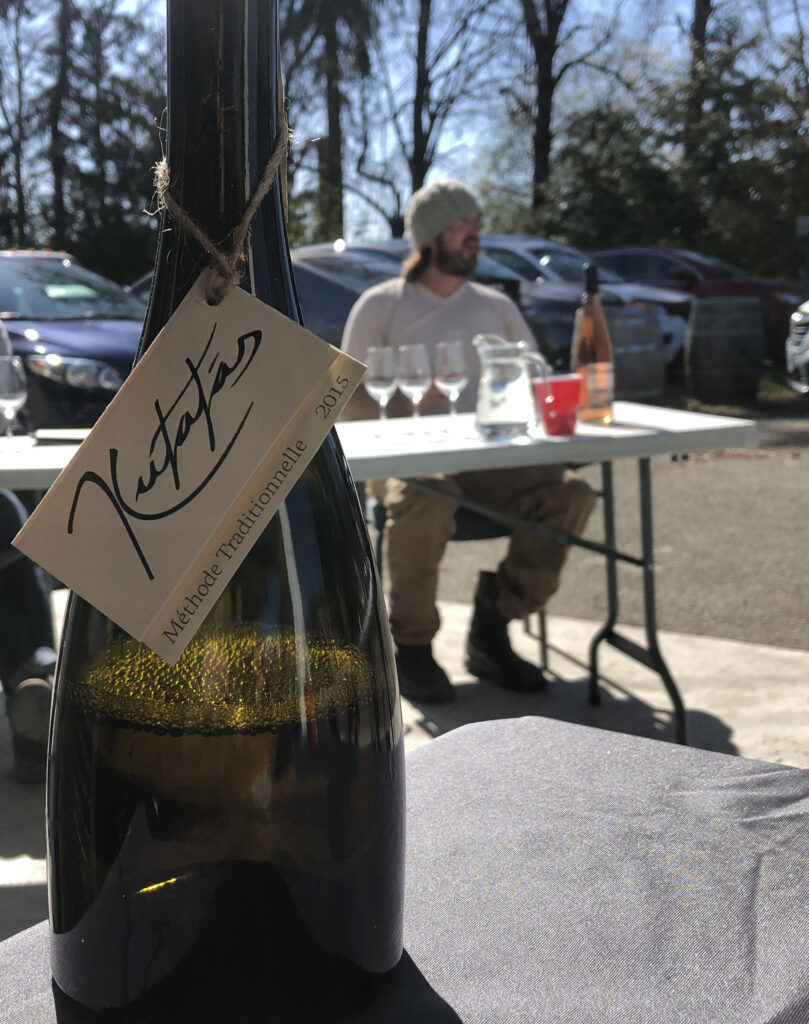
Kutatás Blanc de Noir 2017, Saanich Peninsula, Vancouver Island, British Columbia, Canada
Fruit for this comes from a sustainably managed clay soiled vineyard in North Saanich, planted in 2003. This white Pinot Noir had negligible skin contact before a native ferment in barrel, followed by ten months rest on its lees. The lees are upfront and present, along with a distinct cherry yogurt, stewed rhubarb note that dominates the lactic palate, finishing briefly and dry. Good intent, but the result needs some more tweaking. Happy to see Wine Islands Next Gen experimenting like this. 85/100
Kutatás Methode Traditional Zero Dosage 2015, British Columbia, Canada
This was their first vintage of traditional method, sealed with a crown cap. It’s a 50/50 Pinot Noir / Chardonnay blend, mostly sourced from Vancouver Island with a little bit of Salt Spring Island Chardonnay. It was fermented and rested in older oak, with 4 years on lees. They are disgorging as they go, depending on clients. As one would expect, this is oxidative in style, though somewhat balanced out by the zero dosage and searing acidity. Green and yellow apple, wheat, biscuit, and broken stones, rules the crisp palate, finishing with a saline wash. 150 x 6 packs produced. 87/100
Kutatás Ortega 2018, Saanich Peninsula, Vancouver Island, British Columbia, Canada
This Ortega is a coferment from two sustainably managed dry-farmed vineyards: one in North Saanich, planted in 2003; and from their home site on Salt Spring Island. This vintage marked a shift in their Ortega style. The wine is carbonically macerated prior to native fermentation in stainless (a small portion was in neutral barrel), where it remains on lees for 6 months. Future vintages move entirely to stainless. Melon, gooseberry, grapefruit rind, perfumed lemon and lime blossoms on a slight, soft palate, finishing with a soap twist. This shows more of the grape’s delicate florals, rather than the citrus fruit forward styles we’re used to seeing on the Wine Islands. 87/100
Kutatás Ortega 2017, Saanich Peninsula, Vancouver Island, British Columbia, Canada
From fruit off a sustainably managed clay soiled vineyard in North Saanich, planted in 2003, this wine is carbonic macerated, and native fermented (1/3 in neutral oak) before it remains on lees for 8 months in wood. Crab apple, sour lemon on a lean, lightly oily palate, sided with subtle blond wood, scented with slight florals, and finishing bright and snappy. 87//100
Kutatás Pinot Noir Rosé 2019, Salt Spring Island, British Columbia, Canada
Pouring a mid-pale hue, this Salt Spring Pinot Noir 114 clone Rosé spent 12 hours macerating in the press before being pressed off and ran to barrel for native ferment over 6 months. It spent another 8 months on lees before the final blend. Perfumed and pretty with pink blossom, wild strawberry gliding along a silken palate, seasoned with delicate spicing and gripped with a light texture along the slender sides. Marine fresh. 89/100
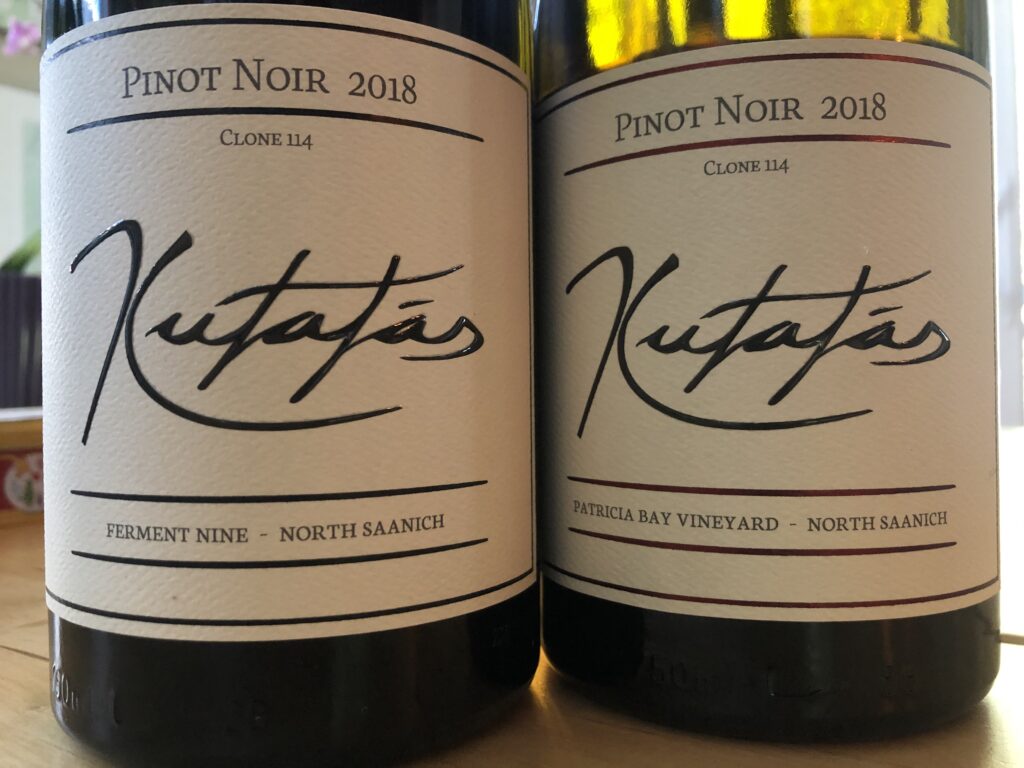
Kutatás Patricia Bay Pinot Noir 2018, Saanich Peninsula, Vancouver Island, British Columbia, Canada
One of two 2018 North Saanich Pinot Noirs from the same 1 hectare, dry-farmed, clay-soiled vineyard. Both are clone 114 at 200+m altitude, and they were picked same day. This bottling was the result of a number of small ferments, blended together. Patty Bay was destemmed and native fermented, run to barrel after about 6 weeks and remained in 1-3 year French oak barrels for about one year before bottling without fining or filtration. Don’t let the massive heavyweight bottles fool you. This is an elegant medium bodied Pinot, full of finesse. Wild raspberries, cherries, plums are lashed with ample marine salinity, and livened with bright acidity on the fresh, textural palate. Tannins are finely grippy, leading this to a lingering pink peppercorn, saline finish. Drinking beautifully now, in youth, but has the structure to cellar over the next few years. Quite impressive, and certainly a winery to watch. While they have a light vit/vini footprint, I hope they can move their packaging into an equally sustainable and modern way. 91/100
Kutatás Ferment Nine Pinot Noir 2018, Saanich Peninsula, Vancouver Island, British Columbia, Canada
One of two 2018 North Saanich Pinot Noirs from the same 1 hectare, dry-farmed, clay-soiled vineyard. Both are clone 114 at 200+m altitude, and they were picked same day. However, for this very limited release (a single ferment), 40% whole cluster was used before a native ferment over 5 weeks, and aging in 2-3 year French oak barrels for 14 months. It was bottled unfined and unfiltered. Don’t let the heavyweight bottles, or thick wax fool you. This is an elegant, medium+ Pinot Noir. Wild raspberries, cherries, black plums are lashed with ample marine salinity, and layered with perfumed plum on the textural, yet silken palate. Tannins are finely grippy and long, housing this to a lingering spiced / saline finish. There’s an alluring dark floral note darting throughout the underneath of this silken wine. Drinking beautifully now, in youth, but has the structure to cellar over the next few years. Certainly a winery to watch. While they have a light vit/vini footprint, I hope they can move their packaging into an equally sustainable and modern way. 90/100
Find these wines with wine-searcher.com

